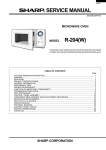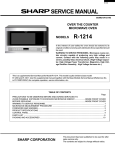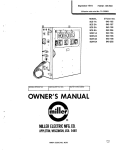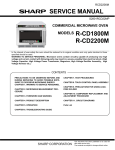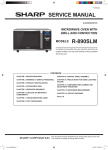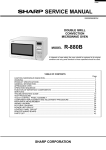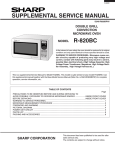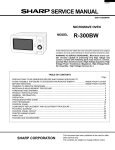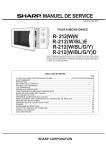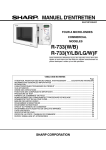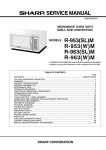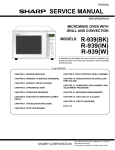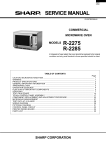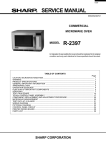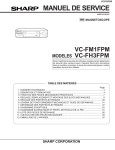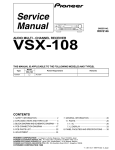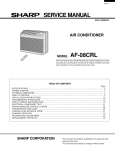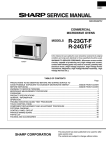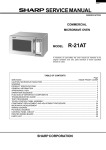Download Sharp R-671 Service manual
Transcript
SERVICE MANUAL ® S10212R671EHW SUPPLEMENT % Kg AUTO COOK MICROWAVE OVEN WITH TOP AND BOTTOM GRILL AUTO DEF WATT /Kg STOP +1min MODEL R-671 R- 671 (W) F In interests of user-safety the oven should be restored to its original condition and only parts identical to those specified should be used. This service manual covers only those items that differ from the S10808R671EHW. R-671(W) TABLE OF CONTENTS REF No PART CODE DESCRIPTION 3-2 HPNLCW076URR0 Control Panel 1 AP 3-5 GMADIA040URR0 Display Window 1 AH 3-6 JBTN-W033URF0 Start Button 1 AE 3-9 JBTN-R029URF0 More /Less Button 1 AD 3-10 JBTN-O020URR0 Pizza Button 1 AD SHARP CORPORATION QTY CODE ® SERVICE MANUAL S10808R671EHW MICROWAVE OVEN WITH TOP AND BOTTOM GRILL % Kg AUTO COOK MODELS AUTO DEF WATT /Kg STOP +1min R-671 R-671(B) R-671(W)E R-671(W) R-671(IN)E R-671(IN) R-671(B)E R-671(W)N In interests of user-safety the oven should be restored to its original condition and only parts identical to those specified should be used. TABLE OF CONTENTS Page CAUTION, MICROWAVE RADIATION .................................................................................................... 2 WARNING ................................................................................................................................................. 3 SERVICING ............................................................................................................................................. 4 PRODUCT SPECIFICATIONS ................................................................................................................. 7 GENERAL INFORMATION ....................................................................................................................... 7 APPEARANCE VIEW .............................................................................................................................. 8 OPERATION SEQUENCE ........................................................................................................................ 9 FUNCTION OF IMPORTANT COMPONENTS ..................................................................................... 11 TROUBLESHOOTING GUIDE ............................................................................................................... 12 TEST PROCEDURE .............................................................................................................................. 13 CONTROL PANEL ASSEMBLY ............................................................................................................ 20 COMPONENT REPLACEMENT AND ADJUSTMENT PROCEDURE .................................................. 24 MICROWAVE MEASUREMENT ........................................................................................................... 30 TEST DATA AT A GLANCE .................................................................................................................. 31 WIRING DIAGRAM ................................................................................................................................ 32 PICTORIAL DIAGRAM .......................................................................................................................... 35 CONTROL PANEL CIRCUIT .................................................................................................................. 36 PRINTED WIRING BOARD .................................................................................................................... 37 PARTS LIST .......................................................................................................................................... 38 CABINET AND UNIT CHASSIS PARTS ................................................................................................. 41 CONTROL PANEL/DOOR PARTS ......................................................................................................... 42 MISCELLANEOUS/PACKING AND ACCESSORIES ............................................................................. 43 SHARP CORPORATION R-671 - 1 CAUTION MICROWAVE RADIATION Personnel should not be exposed to the microwave energy which may radiate from the magnetron or other microwave generating devices if it is improperly used or connected. All input and output microwave connections, waveguides, flanges and gaskets must be secured. Never operate the device without a microwave energy absorbing load attached. Never look into an open waveguide or antenna while the device is energized. VARNING MICKROVAGSSTRALING Personal får inte utsättas för mikrovågsenergi som kan ustrala från magnetronen eller andre mikrovågsalstrande anordningar om dessa är felanslutna eller används på fel sätt. Alla in-och utgångsanslutningar för mikrovågor, vagledare, flänsar och packningar måste vara fast anslutna. Mikrovågsgeneratorn får inte arbeta utan att absorberande belastning är ansluten. Titta aldrig in i ën öppen vågledare eller antenn när mikrovågsgeneratorn är påkopplad eller laddad. VAROITUS MIKROAALTOSÄTELYÄ Käyttäjä ei saa joutua alttiiksi mikroaaltoenergialle, jota voi säteillä magnetronista tai muusta mikroaaltoja kehittävästä laitteesta, jos sitä käytetään tai jos se kytketään väärin. Kaikkien mikroaaltoliitäntöjen sekä syöttö-että ulostulopuolella, aaltoputkien laippojen ja tiivisteiden tulee olla varmistettuja. Mikroaaltouunnia ei koskaan saa käyttää ilman kuormaa jossa mikroaaltoenergiaa kuluu. Avoimeen aaltoputkeen tai antenniin ei koskaan saa katsoa virran ollessa kytkettynä. ADVARSEL MIKROBØLGESTRÅLING Personell må ikke utsettes for mikrobølge-energi som kan utståles fra magnetronen eller andre mikrobølge-generende deler dersom apparatet feilbetjenes eller blir feiltikoplet. Alle inn-og ut-tilkoplinger i forbindelse med mikrobølge-strålingen, bølgeledere, flenser og tetningsringer/pakninger må festes ordentlig. Aldri bruk apparatet med mindre en mikrobålge-absorberende last er plassert i ovnsrommet. Aldri se direkte inn i en åpen bølgeleder eller antenne imens apparatet er strømførende. ADVARSEL MIKROBØLGEBESTRÄLING Man bør ikke udsætte sig for mikrobølgebestråling fra magnetronen eller andre mikrobølgefrembringende anordninger, hvilket kan ske hvis apparatet er forkert tilsluttet eller bruges forkert. Alle mikrobølgeindgange og-udgange, bølgeledere, flanger og tætningsstrimler må være forsvarligt udført. Anvend aldrig ovnen uden en mikrobølgesabsorberende anordning. Se aldrig ind i en åben bølgeleder eller antenne, mens ovnen er i brug. R-671 - 2 SERVICE MANUAL ® MICROWAVE OVEN WITH TOP AND BOTTOM GRILL R-671(B)/ R-671(W)/ R-671(IN) GENERAL IMPORTANT INFORMATION This Manual has been prepared to provide Sharp Corp. Service engineers with Operation and Service Information. It is recommended that service engineers carefully study the entire text of this manual, so they will be qualified to render satisfactory customer service. WARNING Note: The parts marked "*" are used in voltage more than 250V. (Parts List) Anm: Delar märket med "*" har en spänning överstigande 250V. Huom: Huolto-ohjeeseen merkitty "tähdella" osat joissa jännite on yli 250 V. Bemerk: Deler som er merket "asterisk" er utsatt for spenninger over 250V til jord. Bemærk: "Dele mærket med stjerne benyttes med højere spænding end 250 volt. WARNING Never operate the oven until the following points are ensured. (A) The door is tightly closed. (B) The door brackets and hinges are not defective. (C) The door packing is not damaged. (D) The door is not deformed or warped. (E) There is not any other visible damage with the oven. Servicing and repair work must be carried out only by trained service engineers. Removal of the outer wrap gives access to potential above 250V. All the parts marked "∆" on the parts list may cause undue microwave exposure, by themselves, or when they are damaged, loosened or removed. Never operate the Grill and/ or Bottom heater with the oven outer cabinet removed. (Because air flow is eliminated, and the excess heat generated on adjacent components). It can cause permanent damage or fire. SHARP CORPORATION OSAKA, JAPAN R-671 - 3 SERVICING WARNING TO SERVICE PERSONNEL GB Microwave ovens contain circuitry capable of producing very high voltage and current, contact with following parts will result in electrocution. High voltage capacitor, Power transformer, Magnetron, High voltage rectifier assembly, High voltage harness. REMEMBER TO CHECK 3D REMEMBER TO CHECK 4R 1) Disconnect the supply. 2) Door opened, and wedged open. 3) Discharge high voltage capacitor. 1) Reconnect all leads removed from components during testing. 2) Replace the outer case (cabinet). 3) Reconnect the supply. 4) Run the oven. Check all functions. WARNING: AGAINST THE CHARGE OF THE HIGHVOLTAGE CAPACITOR The high-voltage capacitor remains charged about 60 seconds after the oven has been switched off. Wait for 60 seconds and then short-circuit the connection of the highvoltage capacitor (that is, of the connecting lead of the highvoltage rectifier) against the chassis with the use of an insulated screwdriver. Sharp recommend that wherever possible fault-finding is carried out with the supply disconnected. It may in, some cases, be necessary to connect the supply after the outer case has been removed, in this event carry out 3D checks and then disconnect the leads to the primary of the power transformer. Ensure that these leads remain isolated from other components and the oven chassis. (Use insulation tape if necessary.) When the testing is completed carry out 3D checks and reconnect the leads to the primary of the power transformer. NL Microwave ovens should not be run empty. To test for the presence of microwave energy within a cavity, place a cup of cold water on the oven turntable, close the door and set the power to HIGH and set the microwave timer for two (2) minutes. When the two minutes has elapsed (timer at zero) carefully check that the water is now hot. If the water remains cold carry out 3D checks and re-examine the connections to the component being tested. When all service work is completed, and the oven is fully assembled, the microwave power output should be checked and a microwave leakage test carried out. Magnetronovens bevatten circuits die een zeer hoge spanning en stroom kunnen voortbrengen. Contact met de volgende onderdelen kan elektrocutie tot gevolg hebben. Hoogspanningscondensator, hoogspanningstransformator, magnetron, hoogspanningsgelijkrichter, hoogspannings kabelboom. VERGEET DE VOLGENDE 4 STAPPEN NIET VERGEET DE VOLGENDE 3 STAPPEN NIET 1) Haal de stekker uit het stopcontact. 2) Open de deur en zorg ervoor dat hij niet dicht kan vallen. 3) Ontlaad de hoogspanningscondensator. PAS OP VOOR DE ELECTRISCHE LADING VAN DE HOOGSPANNINGSCONDENSATOR De hoogspanningscondensator blijft nog ongeveer 60 seconden lang opgeladen, nadat de oven is uitgeschakeld. Wacht 60 seconden voordat u de verbinding van de hoogspannings-condensator (m.a.w. de verbindingsdraad van de hoogspanningsgelijkrichter) met een geïsoleerde schroevedraaier kortsluit tegen het chassis. Sharp beveelt ten sterkste aan dat, voor zover mogelijk, defecten worden opgespoord wanneer de stekker uit het stopcontact is gehaald. Soms is het nodig om de stroomtoevoer weer tot stand te brengen nadat de buitenmantel verwijderd is. Herhaal dan de bovengenoemde 3 stappen en haal de electrische draden uit de primaire zijde van de vermogenstransformator. Zorg ervoor dat deze draden geïsoleerd blijven van andere elementen en van het chassis van de oven. (Gebruik zo nodig isolatieband.) Wanneer de test is uitgevoerd, herhaalt u de bovenstaande 3 stappen en verbindt u de electrische draden weer aan de primaire zijde van de vermogenstransformator. 1) 2) 3) 4) Sluit de draden weer aan diezijn losgehaald voor de test. Plaats de buitenmantel weer om het toestel heen (kabinet). Stop de stekker weer in het stopcontact. Zet de oven aan. Controleer alle functies. Magnetronovens mogen niet leeg aangezet worden. Om te controleren of er microgolf-energie binnen de oven wordt geproduceerd, plaatst u een mok met koud water op de draaitafel van de oven, sluit de deur, zet de oven op HIGH en stelt de klok van de magnetron in op twee (2) minuten. Wanneer de twee minuten voorbij zijn (klok staat op nul), controleert u voorzichtig of het water heet is. Indien het water nog steeds koud is, herhaalt u de allereerste drie stappen en controleer nogmaals de aansluitingen naar de geteste onderdelen. Wanneer alle reparaties zijn uitgevoerd en de oven weer in elkaar is gezet, moet de het magnetronvermogen worden gecontroleerd en moet worden gecontroleerd of er geen microgolflekkage is. R-671 - 4 SERVICING CONT... E Los hornos de microondas contienen circuitos eléctricos capaces de producir voltajes de alta tensión y descargas eléctricas. Para evitar el riesgo de electrocución, absténgase de tocar los siguientes componentes: condensador de alta tensión, transformador de alta tensión, magnetrón, dispositivo del rectificador de alta tensión y arnés de alta tensión. RECUERDE LA COMPROBACION 3D RECUERDE LA COMPROBACION 4C 1) Desconecte la alimentación. 2) Deje la puerta abierta y calzada. 3) Descargue el condensador de alto voltaje. ADVERTENCIA SOBRE LA CARGA DEL CONDENSADOR DE ALTO VOLTAJE El condensador de alto voltaje permanece cargado unos 60 segundos después de haber apagado el horno. Espere 60 segundos y luego ponga en cortocircuito la conexión del condensador de alto voltaje (esto es, del conductor de conexión del rectificador de alto voltaje) al chasis con un destornillador de mango aislado. Se recomienda encarecidamente que siempre que sea posible la localización de fallos se realice con la alimentación desconectada. Puede ser que en algunos casos sea necesario conectar la alimentación después de haber retirado la carcasa exterior. En este caso, realice las comprobaciones 3D y luego desconecte los conductores del primario del transformador de alimentación. Asegúrese de que estos conductores permanezcan aislados de otros componentes y del chasis del horno. (Use cinta aislante si es necesario). Cuando termine la prueba efectúe las comprobaciones 3D y reconecte los conductores al primario del transformador de alimentación. SV 1) Conecte todos los componentes desconectados de los componentes durante la prueba. 2) Coloque la carcasa exterior (cabina). 3) Conecte la alimentación. 4) Compruebe todas sus funciones despues de poner en marcha el horno. Los hornos de microondas no deben funcionar vacíos. Para comprobar la presencia de energía de microondas dentro de una cavidad, coloque una taza de agua fría en el plato giratorio del horno, cierre la puerta y ponga la potencia en HIGH (alta) y coloque el temporizador en dos (2) minutos. Cuando transcurran los dos minutos (temporizador a cero) compruebe cuidadosamente que el agua se ha calentado. Si el agua permaneciese fría, efectúe las comprobaciones 3D y vuelva a examinar las conexiones de los componentes que han sido probados. Cuando haya terminado la intervención en el equipo y el horno haya sido ensamblado de nuevo completamente, deberá comprobar la potencia de salida de microondas y realizar una prueba de fugas de microondas. Mikrovågsugnar innehåller kretsar som producerar mycket höga spänningar och strömmar. Kontakt med följande komponenter kan leda till dödsfall: Högspänningskondensator, transformator, magnetron, högspännings likriktare, högspännings kablage. KOM IHÅG ATT KONTROLLERA 3 STEG KOM IHÅG ATT KONTROLLERA 4 STEG 1) Koppla från strömkällan. 2) Öppna dörren på glänt. 3) Ladda ur högspänningskondensatorn. 1) 2) 3) 4) VARNING FÖR LADDNINGEN I HÖGSPÄNNINGSKONDENSATORN Högspänningskondensatorn är laddad i 60 sekunder efter det att ugnen stängts av. Vänta 60 sekunder och korislut sedan kondensatoms anslutning (dvs anslutningen till högspänningslikriktaren) till chassiet med hjälp av en isolerad skruvmejsel. Sharp rekommenderar att felsökning sker med strömmen fränkopplad. Ibland kan det var nödvändigt att koppla på strömmen efter det att höljet avlägsnats, utför da 3 Steg kontrollen och koppla sedan från ledarna till transformatorns primärsida. Se till att ledarna är isolerade från andra komponenter och chassiet. (Använd isoleringsband om det behövs). När Du testat färdigt utför Du 3 Steg kontrollen och ansluter ledningarna till transformatorns primärsida igen. Anslut alla ledningar som använts vid testning Sätt tillbaka ytterhöljet. Anslut strömkällan på nytt. Sätt på ugnen. Kontrollera alla funktioner. Mikrovågsugnar får inte användas tomma. Kontrollera mikrovågsstrålningen i olika delar av ugnen genom att placera en kopp med kallt vatten på ugnens tallrik, stäng dörren, ställ in HIGH och ställ in 2 minuter på timern. När två minuter har gått (timem visar 0) kontrollerar du om vattnet är varmt. Om vattnet fortfarande är kallt utför Du 3 steg kontroller och kontrollerar anslutningarna till varje enskild komponent på nytt. När all service är klar och ugnen ihopskruvad skall ugnens uteffekt och eventuellt mikrovågsläckage kontrolleras. R-671 - 5 SERVICING CONT... I I forni a microonde contengono un circuito elettrico in grado di generare tensioni e correnti estremamente elevate. L’eventuale contatto con i seguenti componenti può causare la folgorazione: condensatore ad alta tensione; trasformatore ad alta tensione; magnetron; rettificatore alta tensione; cablaggio ad alta tensione. TRE OPERAZIONI IMPORTANTI PER INCOMINCIARE QUATTRO VERIFICHE IMPORTANTI DA NON DIMENTICARE 1) Scollegare l'alimentazione elettrica. 2) Verificare che la porta sia bloccata in posizione aperta. 3) Scaricare il condensatore ad alta tensione. 1) Ricollegare tutti i conduttori staccati dai vari componenti durante l'intervento. 2) Rimontare la scatola esterna. 3) Ripristinare l'alimentazione elettrica. 4) Rimettere in funzione il forno. Controllare tutte le funzioni. ATTENZIONE AL CONDENSATORE AD ALTA TENSIONE: PUO ESSERE CARICO Il condensatore ad alta tensione rimane carico per circa 60 secondi dopo lo spegnimento del forno. Occorre quindi spettare 60 secondi prima di cortocircuitare, utilizzando un cacciavite con impugnatura isolata, il collegamento del condensatore ad alta tensione (cioè del conduttore di collegamento del raddrizzatore ad alta tensione) sul telaio del forno. Sharp raccomanda, nei limiti del possibile, che la ricerca dei guasti avvenga in assenza di alimentazione elettrica. In alcuni casi tuttavia, può essere necessario alimentare l'apparecchio dopo aver rimosso la scatola esterna. In questo caso eseguire i tre controlli sopra citati e quindi scollegare i connettori dal primario del trasformatore. Assicurarsi che tali connettori non vengano a contatto con altri componenti, ne con il telaio del forno (fare uso, se necessario, di nastro isolante). Al termine dell'intervento, eseguire nuovamente i tre controlli e ricollegare i conduttori al primario del trasformatore. I forni a microonde non devono mai funzionare a vuoto. Per verificare la presenza di energia da microonde all'interno di una cavitá, mettere una tazza di acqua fredda sul piatto rotante del forno, chiudere la porta, regolare la potenza su HIGH ed impostate il temporizzatore su due (2) minuti. Trascorsi i due minuti (temporizzatore a zero), controllare accuratamente che ora l'acqua sia calda. Se l'acqua è rimasta fredda, eseguire i tre controlli iniziali e verificare nuovamente i collegamenti del componente in questione. Dopo aver portato a termine le operazioni di manutenzione e rimontato il forno, è necessario controllare la potenza delle microonde emesse ed eseguire un test per verificare che non vi sia alcuna dispersione. R-671 - 6 PRODUCT DESCRIPTION SPECIFICATION ITEM DESCRIPTION Power Requirements Power Consumption Power Output Grill heating element Power Output (Top Grill) Bottom heating element Power Output Case Dimensions Cooking Cavity Dimensions Turntable diameter Control Complement Set Weight 230 Volts 50 Hertz Single phase, 3 wire earthed Microwave cooking 1.3 kW Approx. 5.8 A Top Grill mode ..................... 0.75 kW Approx. 3.3 A Grill cooking Bottom Grill mode ................ 0.45 kW Approx. 2.0 A Top and Bottom mode ........ 1.15 kW Approx. 5.0 A Micro and Top Grill ................ 2.0 kW Approx. 8.8 A Micro and Bottom Grill ........... 1.7 kW Approx. 7.5 A Dual cooking Micro and Top and Bottom Grill (Auto cook only) ............. 2.4 kW Approx. 10.6 A (Max.) 800 W nominal of RF microwave energy (measured by method of IEC 705) Operating fequency 2450 MHz 700 W 400 W Width 450 mm Height 298 mm including foot Depth 392 mm Width 296 mm Height 203 mm Depth 297 mm 275 mm Touch Control System Clock (1:00 - 12:59 or 0:00 - 23:59) / Timer (0 - 90 minutes) Microwave Power for Variable Cooking Repetition Rate; 100% ................................. Full power throughout the cooking time 70% .................................................. approx. 70% of FULL Power 50% .................................................. approx. 50% of FULL Power 30% .................................................. approx. 30% of FULL Power 10% .................................................. approx. 10% of FULL Power LESS/MORE buttons PIZZA button, AUTO COOK button AUTO DEFROST button, WATT button COOKING MODE selector, STOP button + 1 min./START button, CLOCK setting button TIME/WEIGHT dial Approx. 15 kg GENERAL INFORMATION WARNING THIS APPLIANCE MUST BE EARTHED IMPORTANT THE WIRES IN THIS MAINS LEAD ARE COLOURED IN ACCORDANCE WITH THE FOLLOWING CODE: GREEN-AND-YELLOW BLUE BROWN : : : EARTH NEUTRAL LIVE R-671 - 7 APPEARANCE VIEW OVEN 10 3 11 12 2 1 6 8 5 4 9 7 14 13 1. 2. 3. 4. 5. 6. 7. 8. Control panel Oven lamp Grill heating element (Top Grill) Door opening button Waveguide cover Oven cavity Turntable motor shaft Grill heating element (Bottom Grill) 9. Door seals and sealing surfaces 10.Ventilation openings 11.Outer cabinet 12.Power supply cord 13.Turntable 14.Rack CONTROL PANEL DIGITAL DISPLAY AND INDICATORS 1. WATT indicator 2. WEIGHT indicator 3. LESS /MORE indicator 4. CLOCK indicator 5. COOK indicator 6. AUTO indicator light It will light during automatic operation. 2 3 6 8 9 OPERATION BUTTONS 7. LESS/MORE buttons 8. PIZZA button 9. AUTO COOK button 10.AUTO DEFROST button 11.COOKING MODE selector : MICROWAVE cooking 1 4 5 7 Kg WATT AUTO AUTO COOK 10 AUTO DEF 11 WATT 12 /Kg : DUAL cooking : GRILL cooking 12.WATT button 13.TIME/WEIGHT dial 14.CLOCK setting button 15.STOP button 16.+ 1 min./START button 17.DOOR OPEN button 13 STOP +1 min 16 14 15 R-671 17 R-671 - 8 OPERATION SEQUENCE OFF CONDITION Switch Closing the door activates the primary latch switch and the stop switch. IMPORTANT: When the oven door is closed, the contacts COM-NC of the monitor switch must be open. When the microwave oven is plugged in a wall outlet (230V / 50Hz), the line voltage is supplied to the noise filter. Figure O-1 on page 32 1. The control unit is not energized. The display shows nothing (Fig. O-1 (a)). 2. Open the door. The contacts (COM-NC) of the primary latch switch are closed and the control unit is energized. Then contacts of relays RY1 and RY6 are closed, and the oven lamp will light and the display will flash (Fig. -1(b)). 3. Close the door. The contacts (COM-NC) of the primary latch switch are opened and the oven lamp will be turned off. The display will stop flashing (Fig. O-1(c)). NOTE: Energy save mode 1. If the oven has not been used for more than 2 minutes, the contacts of the relay RY6 will be opened and the control unit will be not energized. Open and close the door, the control unit will resume. 2. If the clock is set, this energy save mode does not work. MICROWAVE COOKING CONDITION HIGH COOKING Select the microwave cooking mode with the COOKING MODE selector. Enter a desired cooking time by turning the TIME/WEIGHT dial and start the oven by pressing START button. Primary latch Switch Stop switch Monitor Switch COM-NO COM-NC COM-NO COM-NO COM-NC Condition During Oven Door Cooking Open(No cooking) Closed Opened Opened Closed Closed Opened Closed Opened Opened Closed The circuit to the high voltage transformer, fan motor and turntable motor are cut off when the primary latch switch and stop switch are made open. The oven lamp remains on even if the oven door is opened after the cooking cycle has been interrupted, because the relay RY1 stay closed. Shown in the display is remaining time. 6. MONITOR SWITCH CIRCUIT The monitor switch SW3 is mechanically controlled by the oven door, and monitors the operation of the primary latch switch SW1. 6-1. When the oven door is opened during or after the cycle of a cooking program, the contacts (COM-NO) of the primary latch switch SW1 and stop switch SW2 must open their contacts first. After that the contacts (COM-NC) of the monitor switch SW3 can be closed. 6-2. When the oven door is closed, the contacts (COMNC) of the monitor switch SW3 must be opened. After that the contacts (COM-NO) of the primary latch switch SW1 and the stop switch SW2 are closed. 6-3. When the oven door is opened and the contacts (COM-NO) of the primary latch switch SW1 remain closed, the fuse F2 F8A will blow, because the monitor switch is closed and a short circuit is caused. MEDIUM HIGH, MEDIUM, MEDIUM LOW, LOW COOKING When the microwave oven is preset for variable cooking power, the line voltage is supplied to the high voltage transformer intermittently within a 32-second time base through the relay contact which is coupled with the current-limiting relay RY2. The following levels of microwave power are given. Function sequence Figure O-2 on page 33 CONNECTED COMPONENTS Oven lamp, Turntable motor High voltage transformer Grill heating element (Top) Bottom heating element Fan motor Control unit Contact RELAY RY1 RY2 RY3 RY4 RY5 RY6 SETTING 32 sec. ON Approx. 100% 800P 100% 1. The line voltage is supplied to the primary winding of the high voltage transformer. The voltage is converted to about 3.3 volts A.C. output on the filament winding and high voltage of approximately 2000 volts A.C. on the secondary winding. 2. The filament winding voltage (3.3 volts) heats the magnetron filament and the high voltage (2000 volts) is sent to the voltage doubling circuit, where it is doubled to negative voltage of approximately 4000 volts D.C.. 3. The 2450 MHz microwave energy produced in the magnetron generates a wavelength of 12.24 cm. This energy is channelled through the waveguide (transport channel) into the oven cavity, where the food is placed to be cooked. 4. When the cooking time is up, a signal tone is heard and the relays RY1 + RY2 + RY5 go back to their home position. The circuits to the oven lamp, high voltage transformer, fan motor and turntable motor are cut off. 5. When the oven door is opened during a cooking cycle, the switches come to the following condition. 560P 400P 240P 80P Note: 24 sec. ON 8 sec. OFF 18 sec. ON 14 sec. OFF 12 sec. ON 20 sec. OFF 6 sec. ON 26 sec. OFF Approx. 70% 70% Approx. 50% 50% Approx. 30% 30% 10% Approx. 10% The On/Off time ratio does not exactly correspond to the percentage of microwave power, because approx. 3 seconds are needed for heating up the magnetron filament. GRILL COOKING CONDITION The oven has three grill cooking condition. They are the TOP GRILL mode, BOTTOM GRILL mode and TOP AND BOTTOM GRILL mode. R-671 - 9 OPERATION SEQUENCE CONT... TOP GRILL MODE In this mode, the food is cooked by the grill heating element (top grill). Select the TOP GRILL mode with the COOKING MODE selector. Enter the cooking time by rotating the TIME/WEIGHT dial. When the START button is pressed, the following operations occur: 1. 2. 3. 4. 5. 6. Figure O-3(a) on page 33 The relay RY1 + RY3 + RY5 are energized. The numbers of the digital readout start the count down to zero. Then the grill heating element (top), turntable motor, oven lamp and fan motor are energized. Now, the food is grilled by the grill heating element. Upon completion of the selected cooking time, audible signal sounds and the contacts of relays RY1 + RY3 are opened, then the grill heating element (top), turntable motor and oven lamp are de-energized. The relay RY5 stays closed for five (5) minutes, and the fan motor operates. BOTTOM GRILL MODE In this mode, the food is cooked by the bottom heating element. Select the BOTTOM GRILL mode with the COOKING MODE selector. Enter the cooking time by rotating the TIME/WEIGHT dial. When the START button is pressed, the following operations occur: 1. 2. 3. 4. 5. 6. Figure O-3(b) on page 33 The relay RY1 + RY4 + RY5 are energized. The numbers of the digital readout start the count down to zero. Then the bottom heating element, turntable motor, oven lamp and fan motor are energized. Now, the food is grilled by the bottom heating element. Upon completion of the selected cooking time, audible signal sounds and the contacts of relays RY1 + RY4 are opened, then the bottom heating elements, turntable motor and oven lamp are de-energized. The relay RY5 stays closed for five (5) minutes, and the fan motor operates. TOP AND BOTTOM GRILL MODE In this mode, the food is cooked by both the grill heating element (top grill) and bottom heating element. Select the TOP AND BOTTOM GRILL mode with the COOKING MODE selector. Enter the cooking time by rotating the TIME/WEIGHT dial. When the START button is pressed, the following operations occur: 1. 2. 3. 4. 5. Figure O-3(c) on page 34 The relay RY1 + RY3 + RY4 + RY5 are energized. The numbers of the digital readout start the count down to zero. Then the grill heating element (top), bottom heating element, turntable motor, oven lamp and fan motor are energized. Now, the food is grilled by the grill heating element (top) and the bottom heating element. Upon completion of the selected cooking time, audible signal sounds and the contacts of relays RY1 + RY3 + RY4 are opened, then the grill heating element (top), bottom heating element, turntable motor and oven lamp are de-energized. 6. The relay RY5 stays closed for five (5) minutes, and the fan motor operates. DUAL COOKING CONDITION The oven has two dual cooking mode. One is MICROWAVE AND TOP GRILL mode and other one is MICROWAVE AND BOTTOM GRILL mode. In both modes, the relay RY2 operates intermittently with in a 48 seconds time base as shown below. Power level ON time OFF time 100% 48 sec. 0 sec. 70% 36 sec. 12 sec. 50% 26 sec. 22 sec. 30% 16 sec. 32 sec. 10% 8 sec. 40 sec. MICROWAVE AND TOP GRILL MODE (DUAL 1) In this mode, the food is cooked by microwave and the grill heating element (top). Select the MICROWAVE AND TOP GRILL mode with the COOKING MODE selector and then select the power level with the WATT button. Enter the cooking time by rotating the TIME/WEIGHT dial. When the START button is pressed, the following operations occur (Fig. O-4(a)): 1. The relay RY1 + RY2 + RY3 + RY5 are energized. 2. The numbers of the digital readout start the count down to zero. 3. The grill heating element (top), high voltage transformer, turntable motor, oven lamp and fan motor are energized. 4. Now, the food is cooked by the microwave and grill heating element (top). 5. Upon completion of the selected cooking time, audible signal sounds and the contacts of relays RY1 + RY2 + RY3 are opened, then the grill heating element (top), high voltage transformer, turntable motor and oven lamp are de-energized. 6. The relay RY5 stays closed for five (5) minutes, and the fan motor operates. MICROWAVE AND BOTTOM GRILL MODE (DUAL 2) In this mode, the food is cooked by microwave and the bottom heating element. Select the MICROWAVE AND TOP GRILL mode with the COOKING MODE selector and then select the power level with the WATT button Enter the cooking time by rotating the TIME/WEIGHT dial. When the START button is pressed, the following operations occur (Fig . O-4(b)): 1. The relay RY1 + RY2 + RY4 + RY5 are energized. 2. The numbers of the digital readout start the count down to zero. 3. The bottom heating element, high voltage transformer, turntable motor, oven lamp and fan motor are energized. 4. Now, the food is cooked by the microwave and bottom heating element. 5. Upon completion of the selected cooking time, audible signal sounds and the contacts of relays RY1 + RY2 + RY4 are opened, then the bottom heating elements, high voltage transformer, turntable motor and oven lamp are de-energized. 6. The relay RY5 stays closed for five (5) minutes, and the fan motor operates. R-671 - 10 OPERATION SEQUENCE CONT... PIZZA COOKING Cooking mode PIZZA automatically works out the correct cooking mode and time for cooking. Chose menu with the PIZZA button and enter the weight of the food with the TIME/WEIGHT dial. Once the oven starts, it will cook according to the special cooking sequence. AUTO COOKING AUTO COOK automatically works out the correct cooking mode and time for cooking. Chose menu with the AUTO COOK button and enter the weight of the food with the TIME/WEIGHT dial. Once the oven starts, it will cook according to the special cooking sequence. AUTO DEFROST AUTO DEFROST automatically works out the correct microwave power and time for defrosting. Chose menu with the AUTO DEF button and to enter the weight of the food with the TIME/WEIGHT dial. Once the oven starts, it will cook according to the special cooking sequence. LIMITATIONS OF POWER OUTPUT IN MANUAL OPERATION After the same cooking mode is carried out for more than the specified cooking time, the power output is automatically reduced by turning the control relays on and off intermittently, as shown in the table below. This is to protect the oven door against temperature rising. Specified cooking time (minutes) Limited power output (%) Time base (seconds) Microwave (100%) 30 70 32 Top grill 30 50 48 Bottom grill 30 50 48 Top grill and Bottom grill 10 (Top) 10 (Bottom) 50 50 48 48 20 (Micro.) 15 (Grill) 70 50 48 48 20 (Micro.) 15 (Heater) 70 50 48 48 Micro. (100%) D U + Top grill A Micro. (100%) L + Bottom grill NOTE: 1. In case of Automatic operations, the limitations of power output are not carried out. 2. In case that the stop button is pressed or the oven door is opened during cooking, the limitations of power output are not carried out after the total cooking time beyond the specified cooking time. 3. In case of the two or more same cooking modes are carried out, the limitations of power output are not carried out after the total cooking time beyond the specified cooking time. 4. In case of the two or more different cooking modes are carried out, the specified cooking time is started to count from the point when the cooking mode is changed. 5. If the cooking mode has the power level display, the power level is also displayed when the limitations of power output are carried out. FUNCTION OF IMPORTANT COMPONENTS DOOR OPEN MECHANISM PRIMARY LATCH SWITCH SW1 The door can be opened by pushing the open button on the control panel. When the open button is pushed, the open lever is pushes lower latch head on the door upward. The latch head is linked with the lower latch head, so now, the door can be opened. 1. When the oven door is closed, the contacts (COM-NO) of the switch must be closed and the contacts (COMNC) must be opened. 2. When the oven door is opened, the contacts (COMNO) of the switch must be opened and the contacts (COM-NC) must be closed. LATCH HOOK MONITOR SWITCH SW3 MONITOR SWITCH DOOR LATCH HEADS 1. When the door is closed, the contacts (COM-NC) must be opened and the contacts (COM-NO) must be closed. 2. When the door is opened, the contacts (COM-NC) must be closed and the contacts (COM-NO) must be closed. 3. If the oven door is opened and he contacts (COM-NO) of the primary latch switch SW1 fail to open, the fuse F2 F8A blows immediately after closing the contacts (COM-NC) of the monitor switch SW3. PRIMARY (MONITORED) LATCH SWITCH STOP SWITCH DOOR OPEN BUTTON OPEN LEVER Figure D-1. Door Open Mechanism STOP SWITCH SW2 1. When the oven door is closed, the contacts (COM-NO) of the switch must be closed. 2. When the oven door is opened, the contacts (COMNO) of switch must be opened. CAUTION: BEFORE REPLACING A BLOWN FUSE F2 F8A TEST THE PRIMARY LATCH SWITCH SW1, MONITOR SWITCH SW3 AND MONITOR RESISTOR (MOUNTED NOISE FILTER) FOR PROPER OPERATION. (REFER TO CHAPTER “TEST PROCEDURE”). R-671 - 11 FUNCTION OF IMPORTANT COMPONENTS CONT... SPECIAL FUSE F1 15A TURNTABLE MOTOR TTM If the wire harness or electrical components are shortcircuited, this fuse F1 blows to prevent an electric shock of fire hazard. The turntable motor drives the turntable roller assembly to rotate the turntable. FUSE F2 F8A 250V FAN MOTOR FM 1. If the wire harness or electrical components are shortcircuited, this fuse blows to prevent an electric shock or fire hazard. 2. The fuse also blows when the primary (monitored) latch switch remains closed with the oven door open and when the monitor switch contact (COM-NC) closes. The fan motor drives a blade which draws external cool air. This cool air is directed through the air vanes surrounding the magnetron and cools the magnetron. This air is channelled through the oven cavity to remove steam and vapours given off from heating food. It is then exhausted through the exhausting air vents of the oven cavity. THERMAL CUT-OUT TC1 145˚C (HVT) NOISE FILTER This thermal cut-out protects the high voltage transformer against overheating. If the temperature goes up higher than 145˚C because the fan motor is interrupted or the ventilation openings are blocked, the thermal cut-out TC1 will open and line voltage to the high voltage transformer will be cut off and the operation of the magnetron will be stopped. The thermal cut-out will cut back in at 115˚C. The noise filter assembly prevents radio frequency interference that might flow back in the power circuit. THERMAL CUT-OUT TC2 150˚C (OVEN) BOTTOM HEATING ELEMENT GH2 This thermal cut-out protects the oven against overheating during grill cooking. The thermal cut-out is also designed to prevent damage to the oven if the foods in the oven catch fire due to over heating produced by improper setting of the cooking time or failure of the control unit. Under the normal operation, the oven thermal cut-out TC2 remains closed. However, when abnormally high temperature are reached within the oven cavity, oven thermal cut-out TC2 will open at 150˚C causing the oven to shut down. The thermal cut-out will cut back in at 130˚C. The bottom heating element GH2 is located on the floor of the oven cavity assembly. The bottom heating element GH2 sends out heat to grill foods. When troubleshooting the microwave oven, it is helpful to follow the Sequence of Operation in performing the checks. Many of the possible causes of trouble will require that a specific test be performed. These tests are given a procedure letter which will be found in the “Test Procedure” section. GRILL HEATING ELEMENT (TOP GRILL) GH1 The grill heating element GH1 is located on the top of the oven cavity assembly. The grill heating element GH1 sends out heat to grill foods. TROUBLESHOOTING GUIDE IMPORTANT: If the oven becomes inoperative because of a blown fuse F2 (F8A) in the primary latch switch - monitor switch, check the primary latch switch and monitor switch before replacing the fuse F2 (F8A). R-671 - 12 TROUBLESHOOTING GUIDE CONT... TEST PROCEDURE POSSIBLE CAUSE AND DEFECTIVE PARTS CONDITION PROBLEM Fuse F1 15A blows when power cord is plugged into wall outlet. Fuse F2 F8A blows when the door is opened. OFF CONDITION Oven lamp does not light when door is opened. (Display operates.) Home fuse blows when power cord is plugged into wall outlet. Nothing appear in display when power cord is plugged into wall outlet and open and close the door. Display does not operate properly when STOP button is pressed. Oven does not start when the START button is pressed. (Display operates.) Oven lamp does not light. (Turntable motor operates.) Fan motor does not operate. (Oven lamp lights.) COOKING CONDITION (COMMON MODE) Turntable motor does not operate. (Oven lamp lights.) Oven or electrical parts does not stop when cooking time is 0 or STOP button is pressed. Oven goes into cook cycle but shuts down before end of cooking cycle. Oven seems to be operating but little or no heat is produced in oven load. MICROWAVE COOKING CONDITION Oven does not operating properly during variable cooking condition except 100% cooking condition. Oven goes into cook cycle but shuts down before end of cooking cycle. GRILL COOKING CONDITION DUAL COOKING CONDITION Grill heating element doesn't operate. (top) Bottom heating element doesn't operate. Oven seems to be operating but little or no heat is produced in oven load. (Microwave power does not seem to be generated properly.) Grill heating element doesn't operate. J J K K L M N N N N N N O MAGNETRON HIGH VOLTAGE TRANSFORMER H.V. RECTIFIER HIGH VOLTAGE CAPACITOR PRIMARY LATCH SWITCH MONITOR SWITCH STOP SWITCH THERMAL CUT-OUT 145˚C (HVT) THERMAL CUT-OUT 150˚C (OVEN) FUSE 15A (F1) FUSE F8A (F2) NOISE FILTER FAN MOTOR TURNTABLE MOTOR GRILL HEATING ELEMENT (TOP) BOTTOM HEATING ELEMENT POWER SUPPLY CORD OVEN LAMP OR SOCKET SHORTED WIRE HARNESS OPENED WIRE HARNESS MIS-ADJUSTMENT OF SWITCHES CONTROL PANEL TACT SWITCH RELAY RY1 RELAY RY2 RELAY RY3 RELAY RY4 RELAY RY5 RELAY RY6 FOIL PATTERN ON P.W.B. LIMITATION OF OPERATION A B C D E E E F F G H I (top) Bottom heating element doesn't operate. R-671 - 13 TEST PROCEDURES PROCEDURE LETTER A MAGNETRON TEST COMPONENT TEST NEVER TOUCH ANY PART IN THE CIRCUIT WITH YOUR HAND OR AN INSULATED TOOL WHILE THE OVEN IS IN OPERATION. CARRY OUT 3D CHECKS. Isolate the magnetron from high voltage circuit by removing all leads connected to filament terminal. To test for an open circuit filament use an ohmmeter to make a continuity test between the magnetron filament terminals, the meter should show a reading of less than 1 ohm. To test for short filament to anode condition, connect ohmmeter between one of the filament terminals and the case of the magnetron (ground). This test should be indicated an infinite resistance. If a low or zero resistance reading is obtained then the magnetron should be replaced. MICROWAVE OUTPUT POWER (IEC-705-1988) The following test procedure should be carried out with the microwave oven in a fully assembled condition (outer case fitted). Microwave output power from the magnetron can be measured by way of IEC 705, i.e. it is measured by how much power the water load can absorb. To measure the microwave output power in the microwave oven, the relation of calorie and watt is used. When P(W) heating works for t(second), approximately P x t/4.187 calorie is generated. On the other hand, if the temperature of the water with V(ml) rises ∆T (°C) during this microwave heating period, the calorie of the water is V x ∆T. The formula is as follows; P x t / 4.187 = V x ∆ T P (W) = 4.187 x V x ∆T / t Our condition for water load is as follows: Room temperature ........... around 20°C Power supply Voltage .............. Rated voltage Water load .................................. 1000 g Initial temperature .............................. 10±2°C Heating time .............................. 52 sec. P = 80 x ∆T Measuring condition: 1. Container The water container must be a cylindrical borosilicate glass vessel having a maximum material thickness of 3 mm and an outside diameter of approximately 190 mm. 2. Temperature of the oven and vessel The oven and the empty vessel are at ambient temperature prior to the start the test. 3. Temperature of the water The initial temperature of the water is (10±2)°C. 4. Select the initial and final water temperature so that the maximum difference between the final water temperature and the ambient temperature is 5K. 5. Select stirring devices and measuring instruments in order to minimize addition or removal of heat. 6. The graduation of the thermometer must be scaled by 0.1°C at minimum and be an accurate thermometer. 7. The water load must be (1000±5) g. 8. “t” is measured while the microwave generator is operating at full power. Magnetron filament heatup time is not included. NOTE: The operation time of the microwave oven is “t + 3” sec. (3 sec. is magnetron filament heat-up time.) Therefore total heating time = 55 sec. Measuring method: 1. Measure the initial temperature of the water before the water is added to the vessel. (Example: The initial temperature T1 = 11°C) 2. Add the 1 litre water to the vessel. 3. Place the load on the centre of the shelf. 4. Operate the microwave oven at HIGH for the temperature of the water rises by a value ∆ T of (10 ± 2) K. 5. Stir the water to equalize temperature throughout the vessel. 6. Measure the final water temperature. (Example: The final temperature T2 = 21°C) 7. Calculate the microwave power output P in watts from above formula. R-671 - 14 TEST PROCEDURES CONT... PROCEDURE LETTER COMPONENT TEST Initial temperature .................................................................................................. T1 = 11°C Temperature after (52 + 3) = 55 sec ...................................................................... T2 = 21°C Temperature difference Cold-Warm ...................................................................... ∆T1 = 10C Measured output power The equation is “P = 80 x ∆T” ...................................................... P = 80 x 10°C = 800 Watts JUDGMENT: The measured output power should be at least ± 15 % of the rated output power. CAUTION: 1°C CORRESPONDS TO 80 WATTS. REPEAT MEASUREMENT IF THE POWER IS INSUFFICIENT. 1000g 1000g 1000g T1˚C T2˚C Heat up for 55 sec B HIGH VOLTAGE TRANSFORMER TEST WARNING: High voltage and large currents are present at the secondary winding and filament winding of the high voltage transformer. It is very dangerous to work near this part when the oven is on. NEVER make any voltage measurements of the high-voltage circuits, including the magnetron filament. CARRY OUT 3D CHECKS. Disconnect the leads to the primary winding of the high voltage transformer. Disconnect the filament and secondary winding connections from the rest of the HV circuitry. Using an ohmmeter, set on a low range, it is possible to check the continuity of all three winding. The following readings should be obtained:a. Primary winding ................................ approximately 2.6 Ω b. Secondary winding .......................... approximately 143 Ω c. Filament winding ......................................... less than 1 Ω If the readings obtained are not stated as above, then the high voltage transformer is probably faulty and should be replaced. CARRY OUT 4R CHECKS. C HIGH VOLTAGE RECTIFIER TEST CARRY OUT 3D CHECKS. Isolate the high voltage rectifier assembly from the HV circuit. The high voltage rectifier can be tested using an ohmmeter set to its highest range. Connect the ohmmeter across the terminal B+C of the high voltage rectifier and note the reading obtained. Reverse the meter leads and note this second reading. The normal resistance is infinite in one direction and more than 100 kΩ in the other direction. CARRY OUT 4R CHECKS. NOTE: FOR MEASUREMENT OF THE RESISTANCE OF THE RECTIFIER, THE BATTERIES OF THE MEASURING INSTRUMENT MUST HAVE A VOLTAGE AT LEAST 6 VOLTS, BECAUSE OTHERWISE AN INFINITE RESISTANCE MIGHT BE SHOWN IN BOTH DIRECTIONS. D HIGH VOLTAGE CAPACITOR TEST CARRY OUT 3D CHECKS. A. Isolate the high voltage capacitor from the circuit. B. Continuity check must be carried out with measuring instrument which is set to the highest resistance range. C. A normal capacitor shows continuity for a short time (kick) and then a resistance of about 10MΩ after it has been charged. R-671 - 15 TEST PROCEDURES CONT... PROCEDURE COMPONENT TEST LETTER D. A short-circuited capacitor shows continuity all the time. E. An open capacitor constantly shows a resistance about 10 MΩ because of its internal 10MΩ resistance. F. When the internal wire is opened in the high voltage capacitor shows an infinite resistance. G. The resistance across all the terminals and the chassis must be infinite when the capacitor is normal. If incorrect reading are obtained, the high voltage capacitor must be replaced. CARRY OUT 4R CHECKS. E SWITCH TEST CARRY OUT 3D CHECKS. Isolate the switch to be tested and using an ohmmeter check between the terminals as described in the following table. Table: Terminal Connection of Switch Plunger Operation COM to NO COM to NC Released Depressed Open circuit Short circuit Short circuit Open circuit COM; Common terminal, NO; Normally open terminal NC; Normally close terminal If incorrect readings are obtained, make the necessary switch adjustment or replace the switch. CARRY OUT 4R CHECKS. F THERMAL CUT-OUT TEST CARRY OUT 3D CHECKS. Disconnect the leads from the terminals of the thermal cut-out. Then using an ohmmeter, make a continuity test across the two terminals as described in the below. Table: Thermal Cut-out Test Parts Name Temperature of "ON" condition (closed circuit). (˚C) Temperature of "OFF" condition (open circuit). (˚C) Indication of ohmmeter (When room temperature is approx. 20˚C.) Thermal cut-out 145˚C Cuts back in at 115˚C. Above 145˚C Closed circuit Thermal cut-out 150˚C Cuts back in at 130˚C. Above 150˚C Closed circuit If incorrect readings are obtained, replace the thermal cut-out. An open circuit thermal cut-out TC1 (HVT) indicates that the high voltage transforner has overheated, this may be due to resistricted ventilation, cooling fan failure or a fault condition within the high voltage transformer or HV. circuit. An open circuit thermal cut-out TC2 (OVEN) indicates that the food in the oven cavity may catch fire, this may be due to over heating produced by improper setting of the cooking timer or failure of the control panel. CARRY OUT 4R CHECKS. G BLOWN FUSE 15A (F1) CARRY OUT 3D CHECKS. If the fuse 15A is blown, there could be a shorts or grounds in electrical parts or wire harness. Check them and replace the defective parts or repair the wire harness. CARRY OUT 4R CHECKS. CAUTION: H Only replace fuse 15A with the correct value replacement. BLOWN FUSE F8A (F2) CARRY OUT 3D CHECKS. If the fuse F8A (F2) is blown when the door is opened, check the primary latch switch, monitor switch and monitor resistor. R-671 - 16 TEST PROCEDURES CONT... PROCEDURE LETTER COMPONENT TEST If the fuse F8A (F2) is blown by incorrect door switching replace the defective switch(es) and the fuse F8A (F2). CARRY OUT 4R CHECKS. CAUTION: I Only replace fuse with the correct value replacement. NOISE FILTER TEST N L LINE CROSS CAPACITOR 0.22µ/250V F1: FUSE 15A CARRY OUT 3D CHECKS. NOISE FILTER 10M/0.5W Disconnect the leads from the terminals of noise filter. Using an ohmmeter, check between the terminals as described in the following table. NOISE SUPPRESSION COIL F2: FUSE F8A RESISTOR 680K/0.5W LINE BYPASS CAPACITOR 4700p/250V LINE BYPASS CAPACITOR 4700p/250V WHT MEASURING POINTS Between N and L Between terminal N and WHITE Between terminal L and RED RED INDICATION OF OHMMETER Approx. 680 kΩ Short circuit Short circuit If incorrect readings are absorbed, replace the noise filter unit. CARRY OUT 4R CHECKS. J MOTOR WINDING TEST CARRY OUT 3D CHECKS. Disconnect the leads from the motor. Using an ohmmeter, check the resistance between the two terminals as described in the table below. Table: Resistance of Motor Motors Resistance Fan motor Approximately 300 Ω Turntable motor Approximately 14.9 kΩ If incorrect readings are obtained, replace the motor. CARRY OUT 4R CHECKS. K GRILL HEATING ELEMENT (TOP) AND BOTTOM HEATING ELEMENT TEST CARRY OUT 3D CHECKS. Before carrying out the following tests make sure the heating element is cool completely. 1. Resistance of heating element. Disconnect the wire leads to the heating element to be tested. Using ohmmeter with low resistance range. Check the resistance across the terminals of the heating element as described in the following table. Table: Resistance of heating element Parts name Resistance Grill heating element (top) Approximately 76 Ω Bottom heating element Approximately 132 Ω 2. Insulation resistance. Disconnect the wire leads to the heating element to be tested. Check the insulation resistance between the element terminal and cavity using a 500V - 100MΩ insulation tester. The insulation resistance should be more than 10 MΩ in the cold start. If the results of above test 1 and/or 2 are out of above specifications, the heating element is probably faulty and should be replaced. CARRY OUT 4R CHECKS. R-671 - 17 TEST PROCEDURES CONT... PROCEDURE COMPONENT TEST LETTER L TOUCH CONTROL PANEL ASSEMBLY TEST The touch control panel consists of circuits including semiconductors such as LSI, ICs, etc. Therefore, unlike conventional microwave ovens, proper maintenance can not be performed with only a voltmeter and ohmmeter. In this service manual, the touch control panel assembly is in two units, control unit and key/jog unit and troubleshooting by replacement is described according to the symptoms indicated. Control Panel. The following symptoms indicate a defective control unit. 1. Tact Switch. The following symptoms indicate a defective tact switch. Replace the tact switch. a) When touching a tact switch, a certain tact switch produces no signal at all. b) When touching a tact switch, sometimes a tact switch produces no signal. 2. In connection with tact switches. a) When touching a tact switch, a certain group of tact switch do not produce a signal. b) When touching a tact switch, no tact switch produce a signal. 3. Potentiometer problem a) When rotating the potentiometer, the cooking mode can not be selected. 4. Encoder problem a) When rotating the encoder, the cooking or the weight of food can not be entered. 5. Display problems. a) At a certain digit, all or some segments do not light up. b) At a certain digit, brightness is low. c) Only one indicator does not light up. d) The corresponding segments of all digits do not light up; or they continue to light up. e) Wrong figure appears. f) A certain group of indicators do not light up. g) The figure of all digits flicker. h) When touching a tact switch, the control unit does not respond. 6. Other possible problems caused by defective control unit. a) Buzzer does not sound or continues to sound. b) Cooking is not possible. M TACT SWITCH TEST 1. Disconnect the oven from the power supply. 2. Discharge the high voltage capacitor. 3. Remove the control unit from the control panel. 4. By using an ohmmeter, check the tact switch operation. 5. When the tact switch is not depressed, an ohmmeter should indicate an open circuit. When the tact switch is depressed, an ohmmeter should indicate a short circuit. If improper operation is indicated, the tact switch is probably defective and should be checked. N RELAY TEST Remove the outer case and check voltage between Pin No. 1 and Pin No. 3 of the 5 pin connector (A) on the control unit with an A.C. voltmeter. The meter should indicate rated voltage, if not check oven circuit. RY1, RY2, RY3, RY4, RY5 and RY6 Relay Test These relays are operated by D.C. voltage Check voltage at the relay coil with a D.C. voltmeter during the microwave cooking operation, grill cooking or dual cooking DC. voltage indicated .......... Defective relay. DC. voltage not indicated .... Check diode which is connected to the relay coil. If diode is good, control unit is defective. RELAY SYMBOL OPERATIONAL VOLTAGE RY1 Approx. 24.0V D.C. Oven lamp / Turntable motor RY2 Approx. 18.0V D.C. High voltage transformer RY3 Approx. 24.0V D.C. Top heating element RY4 Approx. 30.0V D.C. Bottom heating element RY5 Approx. 24.0V D.C. Fan motor RY6 Approx. 24.0V D.C. Touch control transformer R-671 - 18 CONNECTED COMPONENTS TEST PROCEDURES CONT... PROCEDURE COMPONENT TEST LETTER O PROCEDURES TO BE TAKEN WHEN THE FOIL PATTERN ON THE PRINTED WIRING BOARD (PWB) IS OPEN To protect the electronic circuits, this model is provided with a fine foil pattern added to the primary on the PWB, this foil pattern acts as a fuse. If the foil pattern is open, follow the troubleshooting guide given below for repair. Problem: POWER ON, indicator does not light up. CARRY OUT 3D CHECKS. STEPS OCCURRENCE CAUSE OR CORRECTION 1 The rated AC voltage is not present at POWER terminal of CPU connector (CN-A). Check supply voltage and oven power cord. 2 The rated AC voltage is present at primary side of low voltage transformer. Low voltage transformer or secondary circuit defective. Check and repair. 3 Only pattern at "a" is broken. *Insert jumper wire J1 and solder. (CARRY OUT 3D CHECKS BEFORE REPAIR) 4 Pattern at "a" and "b" are broken. *Insert the coil RCILF2003YAZZ between "c" and "d". (CARRY OUT 3D CHECKS BEFORE REPAIR) NOTE: *At the time of these repairs, make a visual inspection of the varistor for burning damage and examine the transformer with a tester for the presence of layer short-circuit (check primary coil resistance). If any abnormal condition is detected, replace the defective parts. T1 R-671 - 19 (J1) RY5 a b CN - A CARRY OUT 4R CHECKS. d VRS1 1 c CONTROL PANEL ASSEMBLY OUTLINE OF CONTROL PANEL The touch control section consists of the following units as shown in the touch control panel circuit. The principal functions of these units and the signals communicated among them are explained below. Tact Switch Signals generated in the LSI are sent to the tact switches. When a tact switch is touched, a signal is completed through the tact switch and passed back to the LSI through to perform the function that was requested. Control Unit Control unit consists of LSI, power source circuit, relay circuit, back light circuit, synchronizing signal circuit, ACL circuit, buzzer circuit, encoder circuit, potentiometer circuit and indicator circuit. 1) LSI This LSI controls the tact switch strobe signal, encoder signal, potentiometer signal, relay driving signal for oven function and indicator signal. 2) Power Source Circuit This circuit generates voltage necessary in the control unit. Symbol Voltage VC -5.0V 4) ACL Circuit A circuit to generate a signals which resets the LSI to the initial state when power is supplied. 5) Buzzer Circuit The buzzer is responsive to signals from the LSI to emit audible sounds (tact switch touch sound and completion sound). 6) Door Sensing Switch A switch to "tell" the LSI if the door is open or closed. 7) Relay Circuit To drive the magnetron, fan motor, turntable motor, top heating element, bottom heating element and light the oven lamp. 8) Indicator Circuit This circuit consists of 4-digits, 12-segments and 3common electrodes using a Liquid Crystal Display. 9) Encoder The encoder converts the signal generated by LSI into the pulse signal, and the pulse signal is returned to the LSI. 10) Potentiometer Circuit The circuit makes setting of the cooking mode by variable resistance. Application LSI(IC1) 3) Synchronizing Signal Circuit The power source synchronizing signal is available in order to compose a basic standard time in the clock circuit. It accompanies a very small error because it works on commercial frequency. 11) Back Light Circuit A circuit to drive the back light (Light emitting diodes LD1-LD4). 12) Auto Indicator Circuit A circuit to drive the light (Light emitting diodes LD5). DESCRIPTION OF LSI LSI(IZA909DR) The I/O signal of the LSI(IZA909DR) are detailed in the following table. Pin No. 1-2 Signal VL2-VL1 I/O IN 3-5 AN7-AN5 IN 6 7 AN4 AN3 OUT IN 8 AN2 IN P01-P00 P57 OUT IN 9-10 11 Description Power source voltage input terminal. Standard voltage for LCD. Terminal to change functions according to the Model. DC voltage in accordance with the Model in operation is applied to set up its function. Terminal not used. Signal coming from potentiometer. By inputting DC voltage corresponding to the cooking mode set by the potentiometer, this input is converted into the cooking mode by the A/D converter built into the LSI. Input signal which communicates the door open/close information to LSI. Door closed; "H" level signal. Door opened; "L" level signal. Terminal not used. Terminal not used. R-671 - 20 DESCRIPTION OF LSI CONT... Pin No. 12 Signal P56 I/O OUT Description Oven lamp and turntable motor driving signal(Square Waveform : 50Hz). To turn on and off shut-off relay (RY1). The square waveform voltage is delivered to the relay (RY1) driving circuit . 13 14 P55 P54 OUT OUT Terminal not used. Signal to sound buzzer. A: key touch sound. B: Completion sound. 20 msec H L During cooking 0.12 sec H: GND A L 2.4 sec H: GND B L 15 P53 OUT 16 P52 OUT 17 P51 OUT 18 P50 OUT 19 P47 OUT P46-P44 INT1 OUT IN INT0 IN 20-22 23 24 Touch control transformer driving signal. To turn on and off the shut off relay ( RY6). If the oven has not been used for more than 2 minutes, the relay RY6 will be turned off. The relay RY6 will be turned on when the oven door is opened and closed. H. GND OFF Fan motor driving signal. ON To turn on and off the fan motor relay RY5. L "L" level during cooking, or for 5 minutes after grill cooking or dual cooking. "H" level During cooking, or for 5 minutes after grill cooking, or dual cooking otherwise. Grill heater (TOP HEATER) driving signal. To turn on and off the grill heater relay During H. GND OFF cooking (RY3). "L" level during grill (TOP GRILL, (Grill or dual) ON L TOP AND BOTTOM) cooking or dual (MICRO+TOP) cooking. "H" level otherwise. Bottom heater driving signal. To turn on and off the bottom relay (RY4). During H. GND OFF "L" level during grill (BOTTOM HEATER, cooking TOP AND BOTTOM) cooking or dual (Grill or dual) ON L (MICRO+BOTTOM) cooking. "H" level otherwise. Magnetron high-voltage circuit driving signal. To turn on and off the cook relay ON/OFF time ratio in MiON/OFF time ratio in Mi(RY2). In 100% POWER cro cooking cro cooking (a. 48second time base) (a. 32second time base) operation, the signals hold "L" level during microwave cooking MICRO ON OFF MICRO ON OFF and "H" level while not cooking. COOK COOK In other cooking modes (70%, 100% 32sec. 0sec. 100% 48sec. 0sec. 50%, 30%, 10%) the signal turns 70% 24sec. 8sec. 70% 36sec. 12sec. to "H" level and "L" level in 50% 18sec. 14sec. 50% 26sec. 22sec. repetition according to the power 30% 12sec. 20sec. 30% 16sec. 32sec. level. 10% 6sec. 26sec. 10% 8sec. 40sec. Terminal not used. Signal coming from encoder. When the encoder is turned, the contacts of encoder make pluse signals. And pulse signals are input into INT1. Signal to synchronized LSI with commercial power source frequency (50Hz). H : GND This is basic timing for time processing of LSI. L (-5V) 20 msec 25 P41 IN 26 P40 IN Signal coming from encoder. Signal similar to INT1. Pulse signals are input into P41. Connected to VC. R-671 - 21 DESCRIPTION OF LSI CONT... Pin No. Signal I/O Description 27 RESET IN 28-29 30 P71-P70 XIN OUT IN 31 XOUT OUT 32 VSS IN 33 P27 OUT 34 P26 OUT 35 P25 OUT P24-P20 P17 OUT IN 42 P16 IN 43 P15 IN 44-48 49-56 57-60 P14-P10 P07-P00 P37-P34 IN OUT IN Auto clear terminal. Signal is input to reset the LSI to the initial state when power is applied. Temporarily set to "L" level the moment power is applied, at this time the LSI is reset. Thereafter set at "H" level. Auto indicator (light emitting diode LD5) driving signal. Internal clock oscillation frequency input setting. The internal clock frequency is set by inserting the ceramic filter oscillation circuit with respect to XIN terminal. Internal clock oscillation frequency control output. Output to control oscillation input of XOUT. Power source voltage: -5V. VC voltage of power source circuit input. Tact switch strobe signal. Signal applied to tact switch section. A pulse signal is input to P15 - P17 terminal while one of tact switches (SW1,SW2,SW3) on matrix is touched. Tact switch strobe signal. Signal applied to tact switch section. A pulse signal is input to P15 - P17 terminal while one of tact switches (SW4-6) on matrix is touched. Tact switch strobe signal. Signal applied to tact switch section. A pulse signal is input to P15 - P17 terminal while one of tact switches (SW7-9) on matrix is touched. Terminal not used. Signalcoming from touch tact switch. When any one of tact switches SW1, SW4, SW7 on key and jog unit matrix is touched, a corresponding signal from P25 - P27 will be input into P17. When no tact switch is touched, the signal is held at "H" level. Signal similar to P17. When any one of tact switches SW2, SW5, SW8 on key and jog unit matrix is touched, a corresponding signal will be input into P16. Signal similar to P17. When any one of tact switches SW3, SW6, SW9 on key and jog unit matrix is touched, a corresponding signal will be input into P15. Terminal not used. Terminal not used. Connected to AVSS 61-72 SEG11-SEG0 OUT Segment data signal. Connected to LCD. The relation between signals are as follows: LSI signal (Pin No.) LCD (Pin No.) LSI signal (Pin No.) LCD (Pin No.) SEG 0 (72) .............................. S1 SEG 6 (66) ........................... S7 SEG 1 (71) .............................. S2 SEG 7 (65) ........................... S8 SEG 2 (70) .............................. S3 SEG 8 (64) ........................... S9 SEG 3 (69) .............................. S4 SEG 9 (63) ......................... S10 SEG 4 (68) .............................. S5 SEG10 (62) ........................ S11 SEG 5 (67) .............................. S6 SEG11 (61) ........................ S12 73/74 VCC/VREF IN/IN Connected to GND. 75 76 77 AVSS COM3 COM2 IN OUT OUT 78 COM1 OUT 79 COM0 OUT 80 VL3 IN Connected to VC. Terminal not used. Common data signal: COM3. Connected to LCD (Pin No. 3). Common data signal: COM2. Connected to LCD (Pin No. 2). Common data signal: COM1. Connected to LCD (Pin No. 1). Power source voltage input terminal. Standard voltage for LCD. 36-40 41 R-671 - 22 SERVICING 1. Precautions for Handling Electronic Components This unit uses CMOS LSI in the integral part of the circuits. When handling these parts, the following precautions should be strictly followed. CMOS LSI have extremely high impedance at its input and output terminals. For this reason, it is easily influenced by the surrounding high voltage power source, static electricity charge in clothes, etc., and sometimes it is not fully protected by the built-in protection circuit. In order to protect CMOS LSI. 1) When storing and transporting, thoroughly wrap them in aluminium foil. Also wrap PW boards containing them in aluminium foil. 2) When soldering, ground the technician as shown in the figure and use grounded soldering iron and work table. approx. 1M ohm 2. Shapes of Electronic Components E C B Transistor 2SB1238 Transistor DTA123ES DTA143ES DTD143ES E CB 3. Servicing of Touch Control Panel We describe the procedures to permit servicing of the touch control panel of the microwave oven and the precautions you must take when doing so. To perform the servicing, power to the touch control panel is available either from the power line of the oven itself or from an external power source. (1) Servicing the touch control panel with power supply of the oven : CAUTION: THE HIGH VOLTAGE TRANSFORMER OF THE MICROWAVE OVEN IS STILL LIVE DURING SERVICING AND PRESENTS A HAZARD . Therefore, when checking the performance of the touch control panel, put the outer cabinet on the oven to avoid touching the high voltage transformer, or unplug the primary terminal (connector) of the high voltage transformer to turn it off; the end of such connector must be insulated with an insulating tape. After servicing, be sure to replace the leads to their original locations. A. On some models, the power supply cord between the touch control panel and the oven itself is so short that the two can't be separated. For those models, check and repair all the controls (sensor-related ones included) of the touch control panel while keeping it connected to the oven. B. On some models, the power supply cord between the touch control panel and the oven proper is so long enough that they may be separated from each other. For those models, therefore, it is possible to check and repair the controls of the touch control panel while keeping it apart from the oven proper; in this case you must short both ends of the door sensing switch (on PWB) of the touch control panel with a jumper, which brings about an operational state that is equivalent to the oven door being closed. As for the sensor-related controls of the touch control panel, checking them is possible if the dummy resistor(s) with resistance equal to that of the controls are used. (2) Servicing the touch control panel with power supply from an external power source: Disconnect the touch control panel completely from the oven proper, and short both ends of the door sensing switch (on PWB) of the touch control panel, which brings about an operational state that is equivalent to the oven door being closed. Connect an external power source to the power input terminal of the touch control panel, then it is possible to check and repair the controls of the touch control panel; it is also possible to check the sensor-related controls of the touch control panel by using the dummy resistor(s). 4. Servicing Tools Tools required to service the touch control panel assembly. 1) Soldering iron: 30W (It is recommended to use a soldering iron with a grounding terminal.) 2) Oscilloscope: Single beam, frequency range: DC 10MHz type or more advanced model. 3) Others: Hand tools 5. Other Precautions 1) Before turning on the power source of the control unit, remove the aluminium foil applied for preventing static electricity. 2) Connect the connector of the key unit to the control unit being sure that the lead wires are not twisted. 3) After aluminium foil is removed, be careful that abnormal voltage due to static electricity etc. is not applied to the input or output terminals. 4) Attach connectors, electrolytic capacitors, etc. to PWB, making sure that all connections are tight. 5) Be sure to use specified components where high precision is required. R-671 - 23 COMPONENT REPLACEMENT AND ADJUSTMENT PROCEDURE WARNING: Avoid possible exposure to microwave energy. Please follow the instructions below before operating the oven. 1. Disconnect oven from power supply. 2. Make sure that a definite “click” can be heard when the microwave oven door is unlatched. (Hold the door in a closed position with one hand, then push the door open button with the other, this causes the latch leads to rise, it is then possible to hear a “click” as the door switches operate.) 3. Visually check the door and cavity face plate for damage (dents, cracks, signs of arcing etc.). Carry out any remedial work that is necessary before operating the oven. Do not operate the oven if any of the following conditions exist; 1. 2. 3. 4. 5. 6. Door does not close firmly. Door hinge, support or latch hook is damaged. The door gasket or seal or damaged. The door is bent or warped. There are defective parts in the door interlock system. There are defective parts in the microwave generating and transmission assembly. 7. There is visible damage to the oven. Do not operate the oven: 1. Without the RF gasket (Magnetron). 2. If the wave guide or oven cavity are not intact. 3. If the door is not closed. 4. If the outer case (cabinet) is not fitted. Please refer to ‘OVEN PARTS, CABINET PARTS, CONTROL PANEL PARTS, DOOR PARTS’, when carrying out any of the following removal procedures: WARNING FOR WIRING To prevent an electric shock, take the following manners. 1. Before wiring, 1) Disconnect the power supply. 2) Open the door and wedge the door open. 3) Discharge the high voltage capacitor and wait for 60 seconds. 2. Don't let the wire leads touch to the following parts; 1) High voltage parts: Magnetron, High voltage transformer, High voltage capacitor and High voltage rectifier assembly. 2) Hot parts: Top heating element, Bottom heating element, Oven lamp, Magnetron, High voltage transformer and Oven cavity. 3) Sharp edge: Bottom plate, Oven cavity, Weveguide flange, Chassis support and other metallic plate. 4) Movable parts (to prevent a fault) Fan blade, Fan motor, Switch, Open lever, Open button. 3. Do not catch the wire leads in the outer case cabinet. 4. Insert the positive lock connector certainly until its pin is locked. And make sure that the wire leads should not come off even if the wire leads is pulled. 5. To prevent an error function, connect the wire leads correctly, referring to the Pictorial Diagram. OUTER CASE REMOVAL To remove the outer case proceed as follows. 1. Disconnect oven from power supply. 2. Open the oven door and wedge it open. 3. Remove the screws from rear and along the side edge of case. 4. Slide the entire case back about 3 cm to free it from retaining clips on the cavity face plate. 5. Lift the entire case from the oven. 6. Discharge the H.V. capacitor before carrying out any further work. 7. Do not operate the oven with the outer case removed. N.B.; Step 1, 2 and 6 form the basis of the 3D checks. CAUTION: DISCHARGE HIGH VOLTAGE CAPACITOR BEFORE TOUCHING ANY OVEN COMPONENT OR WIRING. HIGH VOLTAGE COMPONENTS REMOVAL (HIGH VOLTAGE CAPACITOR AND HIGH VOLTAGE RECTIFIER ASSEMBLY) To remove the components, proceed as follows. 1. CARRY OUT 3D CHECKS. 2. Disconnect all the leads except for the terminal of high voltage rectifier from the high voltage capacitor. 3. Remove one (1) screw holding capacitor holder and high voltage rectifier earth terminal to the power angle. 4. Release the capacitor holder from the power angle. 5. Remove the capacitor from the capacitor holder. 6. Remove the terminal of high voltage rectifier from the high voltage capacitor. 7. Now, the high voltage rectifier and the capacitor should be free. CAUTION: WHEN REPLACING HIGH VOLTAGE RECTIFIER, ENSURE THAT THE CATHODE (EARTH) CONNECTION IS SECURELY FIXED TO THE CAPACITOR HOLDER AND POWER ANGLE WITH AN EARTHING SCREW. R-671 - 24 COMPONENT REPLACEMENT AND ADJUSTMENT PROCEDURE CONT... HIGH VOLTAGE TRANSFORMER REMOVAL 1. CARRY OUT 3D CHECKS. 2. Disconnect the filament leads of high voltage transformer from high voltage capacitor and the magnetron. 3. Disconnect the H.V. wire A from the high voltage transformer. 4. Disconnect the main wire harness from the high voltage transformer. 5. Remove the HVT thermal cut-out from the high voltage transformer. 6. Remove the four (4) screws holding the transformer to power angle. 7. Remove the transformer. 8. Now the high voltage transformer is free. MAGNETRON REMOVAL 1. CARRY OUT 3D CHECKS. 2. Disconnect the H.V. wire B and filament lead of the transformer from the magnetron. 3. Remove the one (1) screw holding the chassis support to the magnetron. 4. Remove the one (1) screw holding the chassis support to the oven cavity front flange. 5. Remove the chassis support from the power angle and move to the right hand side. 6. Release the tabs of air intake duct from the oven cavity. 7. Move the air intake duct to left. 8. Carefully remove two (2) screws holding magnetron to waveguide, when removing the screws hold the magnetron to prevent any damage. 9. Remove the magnetron from the waveguide with care so the magnetron antenna is not hit by any metal object around the antenna. CAUTION: WHEN REPLACING THE MAGNETRON, BE SURE THE R.F. GASKET IS IN PLACE AND THE MAGNETRON MOUNTING SCREWS ARE TIGHTENED SECURELY. CONTROL PANEL ASSEMBLY REMOVAL 1. CARRY OUT 3D CHECKS. 2. Disconnect the main wire harness and the stop switch harness from the control unit. 3. Remove the one (1) screw holding the control panel to the oven cavity front flange. 4. Remove the control panel assembly from the oven. 5. Disconnect the cable from the connector CN-C. 6. Remove the six (6) screws holding the control unit to the control panel. 7. Remove the control unit from the control panel. 8. Remove the six (6) screws holding the key / jog unit to the control panel. 9. Remove the key / jog unit from the control panel. 10.Now, the control unit assembly is free. TURNTABLE MOTOR REPLACEMENT Removal 1. Disconnect the oven from the power supply. 2. Remove the turntable from the oven cavity. 3. Turn the oven over. 4. Cut the four (4) bridges holding the turntable motor cover to the base plate with cutting pliers as shown in Figure C-1(a). CAUTION: DO NOT DROP THE TURNTABLE MOTOR COVER INTO THE OVEN AFTER CUTTING THE BRIDGES. BECAUSE IT WILL DAMAGE THE WIRE LEADS OF THE MOTOR AND IS ALSO DIFFICULT TO REMOVE FROM THE OVEN. 5. Remove the turntable motor cover from the power angle. 6. Disconnect the wire leads from the turntable motor. 7. Remove the one (1) screw holding the turntable motor to the oven cavity. 8. Bend locating tab to allow removal of turntable motor. 9. Remove the turntable motor from the oven cavity taking care not to drop or lose the turntable motor coupling. 10.Now, the turntable motor is free. Re-install 1. Remove the any sharp edges on the turntable motor cover and the base plate with the cutting pliers. 2. Re-install the turntable motor by locating shaft onto coupling then fitting it to the oven cavity with (1) one screw and bending of location tab. 3. Re-connect the wire leads to the turntable motor. 4. Insert the two (2) tabs of the turntable motor cover into the slits of the power angle as shown in Figure C-1(b). 5. Fasten the turntable motor cover to the power angle with the screw (LX-CZA030WRE0) as shown in Figure C-1(b). R-671 - 25 Figure C-1(a). Turntable motor cover removal Cutting pliers Bridges Bridges Turntable motor cover Figure C-1(b). Turntable motor cover re-install Turntable motor cover Tabs Slits Power angle Screw; LX-CZA030WRE0 COMPONENT REPLACEMENT AND ADJUSTMENT PROCEDURE CONT... FAN MOTOR REPLACEMENT REMOVAL 1. CARRY OUT 3D CHECKS. 2. Disconnect the wire leads from the fan motor. 3. Remove the two (2) screws holding the fan motor to the power angle. 4. Remove the fan blade from the fan motor shaft according to the following procedure. 1) Hold the edge of the rotor of the fan motor by using a pair of groove joint pliers. CAUTION: • Make sure that any pieces do not enter the gap between the rotor and the starter of the fan motor. Because the rotor is easy to be shaven by pliers and metal pieces may be produced. • Do not let the pliers touch the coil of the fan motor because the coil may be cut or damaged. • Do not distort the bracket by touching with the pliers. 2) Remove the fan blade from the shaft of the fan motor by pulling and rotating the fan blade with your hand. 3) Now, the fan blade will be free. Because the hole (for shaft) of it may become bigger than a standard one. 5. Now, the fan motor is free. INSTALLATION 1. Install the fan blade to the fan motor shaft according to the following procedure. 1) Hold the centre of the bracket which supports the shaft of the fan motor on a flat table. 2) Install the fan blade to the shaft of fan motor by pushing the fan blade with a small, light weight, ball peen hammer or rubber mallet. CAUTION: • Do not hit the fan blade when installing because the bracket may be deformed. • Make sure that the fan blade rotates smoothly after installation. • Make sure that the axis of the shaft is not slanted. 2. Install the fan motor to the power angle with the two (2) screws. 3. Re-connect the wire leads to the fan motor, referring to the pictorial diagram. CAUTION: • Do not use this removed fan blade again. Shaft Coil Groove joint pliers Shaft Stator Gap Rotor Bracket Table These are the position where should be pinched with pliers Axis Stator Center of bracket Rotor Rear view Side view POSITIVE LOCK® CONNECTOR REMOVAL 1. CARRY OUT 3D CHECKS. 2. Push the lever of Positive lock® connector. 3. Pull down on the Positive lock® connector. Terminal Positive lock® connector 1 CAUTION: WHEN YOU (SERVICE ENGNEERS) CONNECT THE POSITIVE LOCK® CONNECTORS TO THE TERMINALS, CONNECT THE POSITIVE LOCK® SO THAT THE LEVER FACES YOU (SERVICE ENGNEERS). Push Lever 2 Pull down Figure C-2. Positive lock®connector OVEN LAMP REMOVAL 1. CARRY OUT 3D CHECKS. 2. Disconnect the wire lead from the oven lamp, referring to "Positive lock® connector removal". 3. Lift up the oven lamp with release. 4. Now, the oven lamp is free. Shaft Axis Stator These are the positions that should be pinched with pliers. Rotor Figure C-3. Oven lamp R-671 - 26 COMPONENT REPLACEMENT AND ADJUSTMENT PROCEDURE CONT... POWER SUPPLY CORD REPLACEMENT Removal Re-install 1. CARRY OUT 3D CHECKS. 2. Remove the one (1) screw holding the green/yellow wire to the power angle. 3. Disconnect the leads of the power supply cord from the noise filter, referring to the Figure C-4(a). 4. Release the power supply cord from the power angle. 5. Now, the power supply cord is free. 1. Insert the moulding cord stopper of power supply cord into the square hole of the power angle, referring to the Figure C-4(b). 2. Install the earth wire lead of power supply cord to the power angle with one (1) screw and tight the screw. 3. Connect the brown and blue wire leads of power supply cord to the noise filter correctly, referring to the Pictorial Diagram. POWER SUPPLY CORD POWER ANGLE SCREW GREEN / YELLOW WIRE POWER SUPPLY CORD RED WHT BROWN WIRE N TP 15 A L BLUE WIRE MOULDING CORD STOPPER TL CHASSIS SUPPORT POWER ANGLE F8A SQUARE HOLE NOISE FILTER Figure C-4 (a) Replacement of Power Supply Cord Figure C-4(b). Power Supply Cord Replacement TOP HEATING ELEMENT REMOVAL 1. CARRY OUT 3D CHECKS. 2. Remove the two (2) screws holding the two (2) terminals of the main wire harness to the top heating element. 3. Remove the two (2) screws holding the two (2) grill heater angles to the top of the oven cavity. 4. Remove the two (2) grill heater angles from the oven cavity. 5. Remove the top heating element from the top of the oven cavity. 6. Now the top heating element is free. BOTTOM HEATING ELEMENT REMOVAL 1. CARRY OUT 3D CHECKS. 2. Remove the turntable motor cover from the power angle, referring to "TURNTABLE MOTOR REPLACEMENT". 3. Disconnect the wire leads from the bottom heating element. 4. Remove the two (2) nuts holding the bottom heating element to the oven cavity. 5. Remove the heater cover and the heater packing from the bottom heating element. 6. Remove the bottom heating element from the oven cavity . PRIMARY LATCH SWITCH, MONITOR SWITCH AND STOP SWITCH REMOVAL 1. CARRY OUT 3D CHECKS. 2. Remove the control panel assembly referring to "CONTROL PANEL ASSEMBLY REMOVAL". 3. Remove the open lever from the oven cavity front plate by removing the control panel assembly. 4. Disconnect the leads from all switches. 5. Remove the one (1) screw holding the latch hook to the oven cavity. 6. Remove the latch hook. 7. Remove the switch(es) from the latch hook by pushing the retaining tab backwards slightly and turning the switch(es) on the post. 8. Now the switch(es) is free. LATCH HOOK MONITOR SWITCH Tab Post Post PRIMARY (MONITORED) LATCH SWITCH Tab Post Tab STOP SWITCH Figure C-5. Switches R-671 - 27 COMPONENT REPLACEMENT AND ADJUSTMENT PROCEDURE CONT... PRIMARY LATCH SWITCH, STOP SWITCH AND MONITOR SWITCH ADJUSTMENT If the primary latch switch, stop switch and monitor switch do not operate properly due to a mis-adjustment, the following adjustment should be made. 1. CARRY OUT 3D CHECKS. 2. Loosen the one (1) screw holding the latch hook to the oven cavity front flange. 3. With the door closed, adjust the latch hook by moving it back and forward or up and down. In and out play of the door allowed by the latch hook should be less than 0.5 mm. The horizontal position of the latch hook should be placed where the monitor switch has activated with the door closed. The vertical position of the latch hook should be placed where the primary latch switch and stop switch have activated with the door closed. 4. Secure the screws with washers firmly. 5. Make sure of the primary latch switch, stop switch and monitor switch operation. If those switches have not activated with the door closed, one (1) screw holding latch hook to oven cavity front flange and adjust the latch hook position. results (play of the door) should be less than 0.5mm. 2. The contacts (COM-NO) of the primary latch switch and stop switch interrupt the circuit before the door can be opened. 3. The contacts (COM-NC) of the monitor switch close when the door is opened. 4. Re-install outer case and check for microwave leakage around the door with an approved microwave survey meter. (Refer to Microwave Measurement Procedure.) LATCH HOOK MONITOR SWITCH DOOR LATCH HEADS After adjustment, make sure of following: PRIMARY (MONITORED) LATCH SWITCH STOP SWITCH DOOR OPEN BUTTON OPEN LEVER 1. In and out play of door remains less than 0.5 mm when latched position. First check latch hook position, pushing and pulling the door toward the oven face. The Figure C-6 Latch Switches Adjustment DOOR REPLACEMENT REMOVAL 1. CARRY OUT 3D CHECKS. 2. Push the open button and open the door slightly. 3. Insert an putty knife (thickness of about 0.5mm) into the gap between the choke cover and door PANEL as shown in Figure C-7 to free engaging parts. 5. Release choke cover from door panel. 6. Now choke cover is free. head. 12.Now, latch head and latch spring are free. 13.Remove the two (2) screws holding the glass stopper to the door frame. 14.Remove the glass stopper from the door frame. 15.Slide the front door glass leftwards and then slide upwards to release the tabs holding it. 16.Now, the front door glass is free RE-INSTALL 1. Re-install the front door glass to the door frame as follows. 1) Insert the upper edge of the front door glass into the five DOOR PANEL (5) tabs of the door frame. 2) Slide the front door glass downwards and insert the lower edge of the front door glass into the five (5) tabs of the door frame. 3) Slide the front door glass rightwards and insert the right edge of the front door glass into the one (1) long tab of PUTTY KNIFE the door frame. 2. Re-install the glass stopper o the door frame as follows. CHOKE COVER 1) Re-install the glass stopper to the door frame so that the two (2) holes of the glass stopper meet the two (2) DOOR FRAME pins of the door frame. 2) Hold the glass stopper to the door frame with the two 7. Release two (2) pins of door panel from two (2) holes (2) screws. of upper and lower oven hinges by lifting up. 3. Re-install the latch spring to the latch head. Re-install 8. Now, door sub assembly is free from oven cavity. the latch spring to the door frame. Re-install latch head 9. Remove the four (4) screws holding the door panel to to door frame. the door frame. 4. Hold the door panel to the door frame with four (4) 10.Now, door panel is free. screws. 11.Slide latch head upward and remove it from door frame with releasing latch spring from door frame and latch Figure C-7. Door Disassembly R-671 - 28 COMPONENT REPLACEMENT AND ADJUSTMENT PROCEDURE CONT... 5. Catch two (2) pins of door panel on two (2) hole of upper and lower oven hinges. 6. Re-install choke cover to door panel by pushing. Note: After any service to the door; (A) Make sure that door sensing switch and primary latch switch are operating properly. (Refer to chapter "Test Procedures".). (B) An approved microwave survey meter should be used to assure compliance with proper microwave radiation emission limitation standards. (Refer to Microwave Measurement Procedure.) After any service, make sure of the following : 1. Door latch heads smoothly catch latch hook through latch holes and that latch head goes through centre of latch hole. 2. Deviation of door alignment from horizontal line of cavity face plate is to be less than 1.0mm. 3. Door is positioned with its face pressed toward cavity face plate. 4. Check for microwave leakage around door with an approved microwave survey meter. (Refer to Microwave Measurement Procedure.) Note: The door on a microwave oven is designed to act as an electronic seal preventing the leakage of microwave energy from oven cavity during cook cycle. This function does not require that door be air-tight, moisture (condensation)-tight or lighttight. Therefore, occasional appearance of moisture, light or sensing of gentle warm air movement around oven door is not abnormal and do not of themselves, indicate a leakage of microwave energy from oven cavity. Figure C-8. Door Replacement PIN UPPER OVEN HINGE DOOR SUB ASSEMBLY DOOR PANEL LOWER OVEN HINGE CHOKE COVER PIN LOWER OVEN HINGE R-671 - 29 MICROWAVE MEASUREMENT After adjustment of door latch switches, monitor switch and door are completed individually or collectively, the following leakage test must be performed with a survey instrument and it must be confirmed that the result meets the requirements of the performance standard for microwave oven. 2. 3. REQUIREMENT The safety switch must prevent microwave radiation emission in excess of 5mW/cm2 at any point 5cm or more from external surface of the oven. PREPARATION FOR TESTING: Before beginning the actual test for leakage, proceed as follows; 1. Make sure that the test instrument is operating normally as specified in its instruction booklet. Important: Survey instruments that comply with the requirement for instrumentations as prescribed by the performance standard for microwave ovens must be used for testing. 4. 5. 6. Recommended instruments are: NARDA 8100 NARDA 8200 HOLADAY HI 1500 SIMPSON 380M Place the oven tray into the oven cavity. Place the load of 275 ± 15ml of water initially at 20 ± 5˚C in the centre of the oven tray. The water container should be a low form of 600 ml beaker with inside diameter of approx. 8.5cm and made of an electrically non-conductive material such as glass or plastic. The placing of this standard load in the oven is important not only to protect the oven, but also to insure that any leakage is measured accurately. Close the door and turn the oven ON with the timer set for several minutes. If the water begins to boil before the survey is completed, replace it with 275ml of cool water. Move the probe slowly (not faster that 2.5cm/sec.) along the gap. The microwave radiation emission should be measured at any point of 5cm or more from the external surface of the oven. SHARP mW cm 2 mW cm 2 Microwave leakage measurement at 5 cm distance R-671 - 30 TEST DATA AT A GLANCE PARTS Special fuse Fuse Thermal cut-out (HVT) Thermal cut-out (OVEN) Grill heating element (top) Bottom heating element Oven lamp High voltage capacitor Magnetron Power transformer SYMBOL F1 F2 TC1 TC2 GH1 GH2 OL C MG T VALUE / DATA 15A / 250V F 8A 145°C Off / 115˚C On 150°C Off / 130˚C On Approx. 76 Ω / Insulation resistance > 10 MΩ Approx. 132 Ω / Insulation resistance > 10 MΩ 230–240 V 25W AC 2100V 1.02µF Filament < 1Ω / Filament – chassis ∞ ohm. Filament winding < 1Ω Secondary winding Approx. 143 Ω / Primary winding Approx. 2.6 Ω WARNING: DISCONNECT THE PLUG WHEN MEASURING RESISTANCE. R-671 - 31 N RY6 RY2 CONTROL UNIT SW1: PRIMARY LATCH SWITCH R-671 - 32 NC. SW2: STOP SWITCH NC. SW3: MONITOR SWITCH Figure O-1(c) Oven Schematic-OFF Condition after the oven door is closed. H.V. RECTIFIER C: CAPACITOR 1.2µF AC2100V MG: MAGNETRON T: HIGH VOLTAGE TRANSFORMER NC. GH1: GRILL HEATING(TOP) ELEMENT SW1: PRIMARY LATCH SWITCH H.V. RECTIFIER C: CAPACITOR 1.2µF AC2100V MG: MAGNETRON T: HIGH VOLTAGE TRANSFORMER GH1: GRILL HEATING(TOP) ELEMENT GH2: BOTTOM HEATING ELEMENT NC. TURNTABLE MOTOR SW1: PRIMARY LATCH SWITCH TTM RY2 OVEN LAMP FAN MOTOR TURNTABLE MOTOR TTM OVEN LAMP FM A1 N.O. COM. N.O. COM. A9 N.O. COM. H.V. RECTIFIER C: CAPACITOR 1.2µF AC2100V MG: MAGNETRON T: HIGH VOLTAGE TRANSFORMER GH1: GRILL HEATING(TOP) ELEMENT GH2: BOTTOM HEATING ELEMENT OL CONTROL UNIT FAN MOTOR A7 RY5 GH2: BOTTOM HEATING ELEMENT CONTRL OUNIT FM B1 B2 A5 T/C TRANSFORMER TC1: THERMAL CUT-OUT (HVT.) 4700p/ 250V 680 k/ 0.5W " TURNTABLE MOTOR OL A3 TC2: THERMAL CUT-OUT (OVEN) 4700p/ 250V L NOISE SUPPRESSION COIL 10M/ 0.5W F1: FUSE 15A LIVE BRN/15 SCHEMATIC NOTE: CONDITION OF OVEN 1. DOOR CLOSED. 2. PLUGGED IN OVEN. 3. NOTHING APPEARS ON DISPLAY. TTM RY3 N.O. COM. N.O. COM. A9. N.O. COM. EARTH 0.22µ/250V RY2 FAN MOTOR RY5 A7 RY3 N.O. B1 A1 N G-Y/15 RY3 OVEN LAMP RY4 FM RY5 A7 RY1 N.O. NOISE FILTER B2 RY4 COM. RY6 COM. RY1 A5 T/C TRANSFORMER TC1: THERMAL CUT-OUT (HVT.) 4700p/ 250V 680 k/ 0.5W NOISE FILTER A9 N.O. COM. A3 TC2: THERMAL CUT-OUT (OVEN) 4700p/ 250V L NOISE SUPPRESSION COIL 10M/ 0.5W F1: FUSE 15A NEUTRAL 230V ~ 50Hz RY4 B1 A1 EARTH 0.22µ/250V LIVE BLU/15 RY6 B2 T/C TRANSFORMER TC1: THERMAL CUT-OUT (HVT.) 4700p/ 250V N G-Y/15 BRN/15 230V ~ 50Hz RY1 A5 L NEUTRAL BLU/15 NOISE FILTER OL A3 TC2: THERMAL CUT-OUT (OVEN) 10M/ 0.5W F1: FUSE 15A LIVE BRN/15 230V ~ 50Hz NOISE SUPPRESSION COIL 680 k/ 0.5W 0.22µ/250V EARTH G-Y/15 4700p/ 250V NEUTRAL BLU/15 CIRCUIT DIAGRAMS Note: AC CORD CONNECTION BRN : BROWN BLU : BLUE G-Y : GREEN AND YELLOW STRIPE /15 : SECTIONAL AREA OF 1.5mm2 MIN. " Indicates components with potential above 250 V. F2: FUSE F8A SW2: STOP SWITCH NC. SW3: MONITOR SWITCH Figure O-1(a) Oven Schematic-OFF Condition right after the oven is plugged in. SCHEMATIC NOTE: CONDITION OF OVEN 1. DOOR CLOSED. 2. " . 0 " FLASHES ON DISPLAY. F2: FUSE F8A SW2: STOP SWITCH NC. SW3: MONITOR SWITCH Figure O-1(b) Oven Schematic-OFF Condition when the oven door is opened. SCHEMATIC NOTE: CONDITION OF OVEN 1. DOOR CLOSED. 2. DISPLAY DTOPS FLASHING. F2: FUSE F8A N RY6 R-671 - 33 RY3 RY2 CONTROL UNIT SW1: PRIMARY LATCH SWITCH NC. SW2: STOP SWITCH NC. SW3: MONITOR SWITCH Figure O-3(b) Oven Schematic-Grill cooking Condition (BOTTOM GRILL mode) H.V. RECTIFIER C: CAPACITOR 1.2µF AC2100V MG: MAGNETRON T: HIGH VOLTAGE TRANSFORMER GH1: GRILL HEATING(TOP) ELEMENT NC. GH2: BOTTOM HEATING ELEMENT SW1: PRIMARY LATCH SWITCH TURNTABLE MOTOR H.V. RECTIFIER C: CAPACITOR 1.2µF AC2100V MG: MAGNETRON T: HIGH VOLTAGE TRANSFORMER GH1: GRILL HEATING(TOP) ELEMENT GH2: BOTTOM HEATING ELEMENT TURNTABLE MOTOR NC. TTM OVEN LAMP SW1: PRIMARY LATCH SWITCH TTM OL RY2 FAN MOTOR N.O. COM. N.O. COM. A9 N.O. COM. H.V. RECTIFIER C: CAPACITOR 1.2µF AC2100V L MG: MAGNETRON T: HIGH VOLTAGE TRANSFORMER GH1: GRILL HEATING(TOP) ELEMENT GH2: BOTTOM HEATING ELEMENT TURNTABLE MOTOR TTM OVEN LAMP FM A7 A1 TC1: THERMAL CUT-OUT (HVT.) 4700p/ 250V 680 k/ 0.5W T/C TRANSFORMER CONTROL UNIT FAN MOTOR OL B1 B2 A5 10M/ 0.5W F1: FUSE 15A LIVE BRN/15 NOISE SUPPRESSION COIL RY2 FAN MOTOR CONTROL UNIT FM RY5 A7 RY3 N.O. COM. N.O. COM. A9 N.O. COM. A3 TC2: THERMAL CUT-OUT (OVEN) 4700p/ 250V 0.22µ/250V RY5 N.O. B1 A1 N EARTH G-Y/15 230V ~ 50Hz RY3 OVEN LAMP RY4 FM RY5 A7 RY1 COM. NOISE FILTER B2 RY4 N.O. RY6 A5 RY1 COM. A3 T/C TRANSFORMER TC1: THERMAL CUT-OUT (HVT.) 4700p/ 250V 680 k/ 0.5W NOISE FILTER A9 N.O. COM. L NOISE SUPPRESSION COIL 10M/ 0.5W F1: FUSE 15A RY6 B1 A1 TC2: THERMAL CUT-OUT (OVEN) 4700p/ 250V 0.22µ/250V NEUTRAL BLU/15 RY4 B2 T/C TRANSFORMER TC1: THERMAL CUT-OUT (HVT.) 4700p/ 250V N EARTH G-Y/15 LIVE BRN/15 230V ~ 50Hz RY1 A5 L NEUTRAL BLU/15 NOISE FILTER OL A3 TC2: THERMAL CUT-OUT (OVEN) 10M/ 0.5W F1: FUSE 15A LIVE BRN/15 230V ~ 50Hz NOISE SUPPRESSION COIL 680 k/ 0.5W 0.22µ/250V EARTH G-Y/15 4700p/ 250V NEUTRAL BLU/15 CIRCUIT DIAGRAMS CONT... SCHEMATIC NOTE: CONDITION OF OVEN 1. DOOR CLOSED. 2. MICROWAVE COOKING MODE SELECTED. 3. POWER LEVEL CHOSEN. 4. COOKING TIME ENTERED. 5. STRAT BUTTON PRESSED. F2: FUSE F8A SW2: STOP SWITCH NC. SW3: MONITOR SWITCH Figure O-2 Oven Schematic-Microwave cooking Condition SCHEMATIC NOTE: CONDITION OF OVEN 1. DOOR CLOSED. 2. TOP GRILL COOKING MODE SELECTED. 3. COOKING TIME ENTERED. 4. STRAT BUTTON PRESSED. F2: FUSE F8A SW2: STOP SWITCH NC. SW3: MONITOR SWITCH Figure O-3(a) Oven Schematic-Grill cooking Condition (TOP GRILL mode) SCHEMATIC NOTE: CONDITION OF OVEN 1. DOOR CLOSED. 2. BOTTOM GRILL COOKING MODE SELECTED. 3. COOKING TIME ENTERED. 4. STRAT BUTTON PRESSED. F2: FUSE F8A N RY6 R-671 - 34 RY3 RY2 CONTROL UNIT SW1: PRIMARY LATCH SWITCH NC. SW2: STOP SWITCH NC. SW3: MONITOR SWITCH Figure O-4(b) Oven Schematic-Dual cooking Condition (Microwave and Bottom Grill mode) H.V. RECTIFIER C: CAPACITOR 1.2µF AC2100V MG: MAGNETRON T: HIGH VOLTAGE TRANSFORMER GH1: GRILL HEATING(TOP) ELEMENT NC. H.V. RECTIFIER C: CAPACITOR 1.2µF AC2100V MG: MAGNETRON T: HIGH VOLTAGE TRANSFORMER GH1: GRILL HEATING(TOP) ELEMENT GH2: BOTTOM HEATING ELEMENT TURNTABLE MOTOR NC. GH2: BOTTOM HEATING ELEMENT SW1: PRIMARY LATCH SWITCH TTM OVEN LAMP SW1: PRIMARY LATCH SWITCH TURNTABLE MOTOR OL FAN MOTOR TURNTABLE MOTOR TTM OVEN LAMP FM A7 A1 N.O. COM. N.O. COM. A9 N.O. COM. H.V. RECTIFIER C: CAPACITOR 1.2µF AC2100V MG: MAGNETRON T: HIGH VOLTAGE TRANSFORMER GH1: GRILL HEATING(TOP) ELEMENT GH2: BOTTOM HEATING ELEMENT OL CONTROL UNIT FAN MOTOR RY2 FAN MOTOR N.O. B1 T/C TRANSFORMER TC1: THERMAL CUT-OUT (HVT.) 4700p/ 250V RY2 TTM RY4 COM. L Indicates components with potential above 250 V. OVEN LAMP CONTROL UNIT FM RY5 A7 RY3 N.O. B1 N.O. B2 A5 10M/ 0.5W F1: FUSE 15A LIVE BRN/15 NOISE SUPPRESSION COIL 680 k/ 0.5W RY5 FM RY5 A7 RY1 COM. A9 N.O. COM. A3 TC2: THERMAL CUT-OUT (OVEN) 4700p/ 250V 0.22µ/250V EARTH G-Y/15 RY3 COM. NOISE FILTER N.O. RY6 B2 RY4 COM. RY1 A5 A1 NOISE FILTER A9 N.O. COM. T/C TRANSFORMER TC1: THERMAL CUT-OUT (HVT.) 4700p/ 250V N RY6 B1 A1 A3 TC2: THERMAL CUT-OUT (OVEN) L NEUTRAL RY4 B2 T/C TRANSFORMER TC1: THERMAL CUT-OUT (HVT.) 4700p/ 250V 4700p/ 250V 10M/ 0.5W F1: FUSE 15A LIVE NOISE SUPPRESSION COIL 680 k/ 0.5W 0.22µ/250V EARTH G-Y/15 BRN/15 230V ~ 50Hz RY1 A5 L N NEUTRAL BLU/15 BLU/15 NOISE FILTER OL A3 TC2: THERMAL CUT-OUT (OVEN) 10M/ 0.5W F1: FUSE 15A LIVE BRN/15 NOISE SUPPRESSION COIL 680 k/ 0.5W 0.22µ/250V EARTH G-Y/15 4700p/ 250V NEUTRAL BLU/15 230V ~ 50Hz 230V ~ 50Hz CIRCUIT DIAGRAMS CONT... SCHEMATIC NOTE: CONDITION OF OVEN 1. DOOR CLOSED. 2. TOP AND BOTTOM GRILL COOKING MODE SELECTED. 3. COOKING TIME ENTERED. 4. STRAT BUTTON PRESSED. F2: FUSE F8A SW2: STOP SWITCH NC. SW3: MONITOR SWITCH Figure O-3(c) Oven Schematic-Grill cooking Condition (TOP AND BOTTOM GRILL mode) SCHEMATIC NOTE: CONDITION OF OVEN 1. DOOR CLOSED. 2. DUAL 1 COOKING MODE SELECTED. 3. POWER LEVEL SELECTED. 4. COOKING TIME ENTERED. 5. STRAT BUTTON PRESSED. F2: FUSE F8A SW2: STOP SWITCH NC. SW3: MONITOR SWITCH Figure O-4(a) Oven Schematic-Dual cooking Condition (Microwave and Top Grill mode) SCHEMATIC NOTE: CONDITION OF OVEN 1. DOOR CLOSED. 2. DUAL 2 COOKING MODE SELECTED. 3. POWER LEVEL SELECTED. 4. COOKING TIME ENTERED. 5. STRAT BUTTON PRESSED. F2: FUSE F8A G R Y Y L W R-671 - 35 RY4 COM RY3 RY6 RY1 COM COM RY2 1 CN-C 11 9 T1 CN-A RY5 1 CN-B 2 CONTROL UNIT 1 CN-A BRN RED BLK BLK RED BLK ORG GRN RED GRY WHT BLU YLW RED GRN CN-B GRN 1 2 3 4 5 6 7 9 8 1 2 WHT BLU GRY RED GRY GRY TTM: TURNTABLE MOTOR GH2: BOTTOM HEATING ELEMENT WHT YLW RED ORG WHT BLU TC2: THERMAL CUT-OUT(OVEN) GH1: TOP GRILL HEATING ELEMENT ORG Figure S-1. Pictrorial Diagram GRN SW2: STOP SWITCH NO RED NC COM COM COM SW1: PRIMARY LATCH SWITCH SW3: MONITOR SWITCH N.C. WHT RED WHT BRN RED TC1: THERMAL CUT-OUT(HVT) ORG WHT OL: OVEN LAMP WHT WHT WHT YLW GRY YLW L N TL BLU F8A WHT WHT FM: FAN MOTOR BRU G/Y POWER SUPPLY CORD T: HIGH VOLTAGE TRANSFORMER H.V.WIRE B H.V. RECTIFIER H.V.WIRE A MG: MAGNETRON C: H.V. CAPACITOR HIGH VOLTAGE COMPONENTS BLK RED WHT NEUTRAL LIVE NOISE FILTER TP BRN 15 A WHT RED WHT YLW CIRCUIT DIAGRAMS CONT... HIGH VOLTAGE TRANSFORMER TOP HEARTING ELEMENT BOTTOM HEARTING ELEMENT FAN MOTOR c a 4 Q3 2SB1238 RY2 RY3 RY1 RY4 RY5 RY6 b 10G471K 8 6 D2 D1 R9 1k : 0.1µ / 16v : 1/4w ± 5% : 1SS270A NOTE : IF NOT SPECIFIED N.O. COM N.O. COM N.O. COM A9 A7 A5 A3 VRS1 d (J1) AC230V 50Hz T1 C3 0.1µ/50v 1 D4 D3 C1 0.1µ/50v – + CN-B R10 240 2 R40 3.3k R2 510 1w (J8) C20 0.1µ/50v ZD1 HZ5C-2 SW60 – + C6 10µ/35v B C CN-C 6 R4 4.7k R52 100k R53 100k R51 4.7k R50 4.7k R30 15k Encoder A Q1 DTA123ES C4 2 1 AUTO LD5 LD5 C53 C52 VC GND Figure S-2. Control Panel Circuit Q21 DTA143ES DOOR 1 SP1 Q4 2SB1238 R1 510 1w C21 10µ /35v C2 1000µ/35v D26 11ES1 Q25 DTA143ES Q23 DTA143ES Q22 DTD143ES Q24 DTD143ES Q26 DTA143ES Q20 DTA143ES Q2 DTA143ES – + LD1 LD2 LD3 LD4 – Q40 DTA143ES C5 WH-2 (J4) Back Light R5 4.7k (J2) (J3) A1 D20 D25 D24 D21 D23 D22 ZD3 HZ20-1 + ZD2 HZ4A2 R31 4.7k (J6) (J5) R80 1.5k D1-4 11ES1 D30 (J7) 5 VR1 10k 4 R8 10k R7 10k R6 10k 1 2 3 4 5 6 7 8 9 10 11 12 13 14 15 16 17 18 19 20 21 22 23 24 WH-B 3 CF1 CST4.00MGW R12 4.7k VL2 VL1 AN7 AN6 AN5 AN4 AN3 AN2 P61 P60 P57 P56 P55 P54 P53 P52 P51 P50 P47 P46 P45 P44 INT1 INT0 C7 0.1µ/50v VL3 COM0 COM1 COM2 COM3 AVSS VREF VCC SEG0 SEG1 SEG2 SEG3 SEG4 SEG5 SEG6 SEG7 I-1 IZA909DR M38223M4 80 79 78 77 76 75 74 73 72 71 70 69 68 67 66 65 25 26 27 28 29 30 31 32 33 34 35 36 37 38 39 40 8 SW7 AUTO COOK WATT SW8 AUTO DEF SW9 7 P41 P40 RESET P71 P70 XIN XOUT VSS P27 P26 P25 P24 P23 P22 P21 P2 0 R69 15k R-671 - 36 R70 15k C30 11 10 9 64 SEG8 63 SEG9 62 SEG10 61 SEG11 60 P34 59 P35 58 P36 57 P37 56 P00 55 P01 54 P02 53 P03 52 P04 51 P05 50 P06 49 P07 48 P10 47 P11 46 P12 45 P13 44 P14 43 P15 42 P16 41 P17 SW2 3 START 9 + 1 min 7 STOP SW3 5 SW1 S1 S2 S3 S4 S5 S6 S7 S8 S9 S10 S11 S12 R68 15k CN-A 8 6 4 C3 C2 C1 10 2 CR60 1 CIRCUIT DIAGRAMS CONT... SW1 A B C ( CPU UNIT ) Figure S-3. Printed Wiring Board R-671 - 37 SW1 R50 VR1 R51 ( KEY AND JOG UNIT ) WH - B C51 C50 20 SW8 SW9 SW4 SW5 SW6 LD5 SW7 R52 R53 DCUT A 1 2 3 21 22 23 24 WH - B C51 C50 20 R51 B C R50 VR1 SW8 SW9 SW4 SW5 SW6 LD5 SW7 R52 R53 1 2 3 21 22 23 24 CIRCUIT DIAGRAMS CONT... DCUT PARTS LIST Note: The parts marked "∆" may cause undue microwave exposure. / The parts marked "*" are used in voltage more than 250V. / "§" Mark: Spare parts delivery section. ELECTRIC PARTS * ∆* * * REF. NO. C F1 F2 FM GH1 GH2 MG OL SW1 SW2 SW3 T TC1 TC2 TTM 1- 1 1- 2 1- 3 PART NO. RC-QZA207WRE0 QFS-B0019MRE0 QFS-CA024WRE0 RMOTEA360WRE0 RHET-A206WRE0 RHET-A210WRE0 RV-MZA279WRE0 RLMPTA066WRE0 QSW-MA112WRE0 QSW-MA110WRE0 QSW-MA112WRE0 RTRN-A010URE0 RTHM-A108WRE0 RTHM-A099WRE0 RMOTDA227WRE0 RH-DZA048WRE0 FPWBFA309WRE1 QACCVA004URE1 § U U U U U U U U J J J U U U U U U U DESCRIPTION High voltage capacitor Fuse 15A Fuse F8A Fan motor Top heating element Bottom heating element Magnetron Oven lamp Primary latch switch Stop switch Monitor switch High voltage transformer Thermal cut-out 145˚C off 115˚C on (HVT) Thermal cut-out 150˚C off 130˚C on (OVEN) Turntable motor High voltage rectifier Noise filter Power supply cord Q'TY 1 1 1 1 1 1 1 1 1 1 1 1 1 1 1 1 1 1 CODE AS AC AC AU AX AX BD AK AN AK AN BG AG AH AU AM AT AQ U U U U Outer case cabinet R-671(B) Outer case cabinet R-671(W) Outer case cabinet R-671(IN) Foot 1 1 1 2 AT AW AY AB U U U U U U U U U U U U U U U U U U U U U U U U U J U U U U U U U U U U U Control unit 5-pin connector (CN-A) 2-pin connector (CN-B) 11-pin connector (CN-C) Liquid crystal display LCD holder LED sheet 2-pin harness (WH-A) 11-pin harness (WH-B) Capacitor 0.1 uF 50V Capacitor 1000 uF 35V Capacitor 0.1 uF 50V Capacitor 0.01 uF 16V Capacitor 10 uF 35V Capacitor 0.1 uF 50V Capacitor 0.1 uF 50V Capacitor 10 uF 35V Capacitor 0.01 uF 16V Capacitor 0.01 uF 16V Ceramic resonator (CST4.00MGW) Capacitor array Diode (11ES1) Diode (1SS270A) Diode (11ES1) Diode (1SS270A) LSI Light emitting diode Light emitting diode Transistor (DTA123ES) Transistor (DTA143ES) Transistor (2SB1238) Transistor (DTA143ES) Transistor (DTD143ES) Transistor (DTA143ES) Transistor (DTA143ES) Transistor (DTA143ES) Transistor (DTA143ES) 1 1 1 1 1 1 1 1 1 1 1 1 2 1 1 1 1 1 2 1 1 4 6 1 1 1 4 1 1 1 2 2 1 2 1 1 1 BL AC AB AC AK AC AC AK AN AB AB AB AA AB AB AA AB AA AA AD AG AB AA AB AA AS AC AC AB AB AD AB AC AB AB AB AB CABINET PARTS 2222- 1 1 1 2 GCABUA010URP0 GCABUA471WRT0 GCABUA026URP0 GLEGPA057WRE0 CONTROL PANEL PARTS 3- 1 3- 1A 3- 1B 3- 1C 3- 1D 3- 1E 3- 1F 3- 1G 3- 1H C1 C2 C3 C4-5 C6 C7 C20 C21 C30 C52-53 CF1 CR60 D1-4 D20-25 D26 D30 I-1 LD1-4 LD5 Q1 Q2 Q3-4 Q20-21 Q22 Q23-24 Q25 Q26 Q40 DPWBFB840WRK0 QCNCMA453DRE0 QCNCMA414DRE0 QCNCMA335DRE0 RLCDSA036DRE0 LHLD-A187WRF0 PSHEPA569WRE0 FW-VZA240DRE0 FW-VZA241DRE0 RC-KZA087DRE0 VCEAB31VW108M RC-KZA087DRE0 VCKYD41CY103N VCEAB31VW106M RC-KZA087DRE0 VCEAB31HW104M VCEAB31VW106M VCKYD41CY103N VCKYD41CY103N RCRS-A012DRE0 RMPTEA011DRE0 VHD11ES1///-1 VHD1SS270A/-1 VHD11ES1///-1 VHD1SS270A/-1 RH-IZA909DRE0 VHPSLZ781C9-3 VHPLTL1CHE/-3 VSDTA123ES/-3 VSDTA143ES/-3 VS2SB1238//-3 VSDTA143ES/-3 VSDTD143ES/-3 VSDTA143ES/-3 VSDTA143ES/1B VSDTA143ES/-3 VSDTA143ES/-3 R-671 - 38 PARTS LIST CONT... CONTROL PANEL PARTS CONT... ∆ REF. NO. R1-2 R4-5 R6-8 R9 R10 R12 R30 R31 R40 R50-51 R52-53 R68-70 R80 RY1 RY2 RY3 RY4 RY5-6 SP1 SW4-9 T1 VR1 VRS1 ZD1 ZD2 ZD3 3- 2 3- 2 3- 2 3- 3 3- 3 3- 3 3- 4 3- 5 3- 6 3- 6 3- 6 3- 7 3- 7 3- 7 3- 8 3- 8 3- 8 3- 9 3- 10 3- 11 3- 11 3- 11 3- 12 3- 12 3- 12 3- 13 3- 14 PART NO. VRS-B13AA511J VRD-B12EF472J VRD-B12EF103J VRD-B12EF102J VRD-B12EF241J VRD-B12EF472J VRD-B12EF153J VRD-B12EF472J VRD-B12EF332J VRD-B12EF472J VRD-B12EF104J VRD-B12EF153J VRD-B12EF152J RRLY-A076DRE0 RRLY-A092DRE0 RRLY-A076DRE0 RRLY-A115DRE0 RRLY-A080DRE0 RALM-A014DRE0 QSW-PA016DRE0 RTRNPA105DRE0 RVR-BA014DRE0 RH-VZA032DRE0 VHEHZ5C2///-1 VHEHZ4A2///-1 VHEHZ201///-1 HPNLCB010URR0 HPNLCS005URR0 HPNLCW019URR0 JBTN-B014URF0 JBTN-K019URF0 JBTN-W008URF0 MSPRCA045WRE0 GMADIA015URR0 JBTN-B003URF0 JBTN-G001URF0 JBTN-K020URF0 JBTN-B004URR0 JBTN-K016URR0 JBTN-W010URR0 JBTN-B007URF0 JBTN-K018URF0 JBTN-W013URF0 JBTN-K008URF0 JBTN-O004URR0 JKNBKB003URF0 JKNBKK004URF0 JKNBKW003URF0 JKNBKB004URF0 JKNBKK003URF0 JKNBKW004URF0 MSPR-A002URE0 XEPSD30P10XS0 § U U U U U U U U U U U U U U U U U U U U U U U U U U U U U U U U U U U U U U U U U U U U U U U U U U U U U DESCRIPTION Resistor 510 ohm 1W Resistor 4.7k ohm 1/4W Resistor 10k ohm 1/4W Resistor 1.0k ohm 1/4W Resistor 240 ohm 1/4W Resistor 4.7k ohm 1/4W Resistor 15k ohm 1/4W Resistor 4.7k ohm 1/4W Resistor 3.3k ohm 1/4W Resistor 4.7k ohm 1/4W Resistor 100k ohm 1/4W Resistor 15k ohm 1/4W Resistor 1.5k ohm 1/4W Relay (OMIF-S-124LM) Relay (VRB18SP) Relay (OMIF-S-124LM) Relay (JV-24S-KT) Relay (OJ-SH-124LM) Buzzer (PKM22EPT-THAI) Tact switch Transformer Potentiometer Varistor (10G471K) Zener diode (HZ5C2) Zener diode (HZ4A2) Zener diode (HZ20-1) Control panel [R-671(B)] Control panel [R-671(IN)] Control panel [R-671(W)] Open button [R-671(B)] Open button [R-671(IN)] Open button [R-671(W)] Open button spring Display window Start button [R-671(B)] Start button [R-671(W)] Start button [R-671(IN)] Auto/Def button [R-671(B)] Auto/Def button [R-671(IN)] Auto/Def button [R-671(W)] Watt/Stop button [R-671(B)] Watt/Stop button [R-671(IN)] Watt/Stop button [R-671(W)] More/Less button Pizza button Select knob [R-671(B)] Select knob [R-671(IN)] Select knob [R-671(W)] Timer knob [R-671(B)] Timer knob [R-671(IN)] Timer knob [R-671(W)] Switch spring Screw; 3mm x 10mm U U U U U U U U U U U H.V. Capacitor holder Power angle Oven cavity Turntable shaft assembly Vibration proof cushion Exhaust duct angle Exhaust duct Latch hook Fan blade Chassis support Turntable motor angle Q'TY 2 2 3 1 1 1 1 1 1 2 2 3 1 1 1 1 1 2 1 6 1 1 1 1 1 1 1 1 1 1 1 1 1 1 1 1 1 1 1 1 1 1 1 1 1 1 1 1 1 1 1 1 12 CODE AB AA AA AA AA AA AA AA AA AA AA AA AA AK AP AK AK AG AG AB AR AD AC AB AB AB AN AN AN AE AE AE AA AE AC AC AC AE AE AE AC AC AE AC AD AF AE AE AF AE AE AB AA 1 1 1 1 1 1 1 1 1 1 1 AD AC BL AM AA AE AL AH AM AE AD OVEN PARTS ∆ ∆ ∆ 4- 1 4- 2 4- 3 4- 4 4- 5 4- 6 4- 7 4- 8 4- 9 4-10 4-11 LBNDKA111WRP0 LANGTA004URP0 DOVN-A012URY0 FANGTA002URY0 PSPAGA001WRE0 LANGQA010URP0 PDUC-A006URP0 PHOK-A092WRF4 NFANJA029WRE0 LANGFA169WRP5 LANGQA006URP0 R-671 - 39 PARTS LIST CONT... OVEN PARTS CONT... ∆ * * REF. NO. 4-12 4-13 4-14 4-15 4-16 4-17 4-18 4-19 4-20 4-21 4-22 4-23 4-24 4-25 4-26 4-27 4-28 PART NO. LANGQA007URP0 LANGQA008URP0 MLEVFA078WRF0 MSPRCA004URE0 PCOVPA309WRE0 PCOVQA002URP0 PCUSGA360WRP0 PCUSUA020URE0 PDUC-A005URP0 PDUC-A581WRF3 PDUC-A638WRF2 PGSK-A001URE0 PPACGA001URE0 PSKR-A003URF0 PCUSGA003URP0 PCUSUA021URE0 PCLI-A001URE0 § U U U U U U U U U U U U U U U U U DESCRIPTION Air duct angle Grill heater angle Open lever Sealed spring Waveguide cover Heater cover HVT cushion Cushion Air duct Air intake duct Fan duct O-ring gasket Heater packing Rear barrier Cushion (TTM cover) Door cushion Harness clip Q'TY 1 1 1 1 1 1 1 1 1 1 1 1 1 1 2 1 1 CODE AG AD AE AA AC AD AA AA AG AE AE AB AD AE AC AC AA U U U U U U U U U U Door panel assembly Choke cover Door frame R-671(B) Door frame R-671(W) Door frame R-671(IN) Glass stopper Latch head Latch spring Front door glass Screw : 3mm x 6mm 1 1 1 1 1 1 1 1 1 6 AY AK AY AY AY AB AD AA AS AA U U U U U U U U U U U U Operation manual Operation manual (R-671(W)N) Turntable Trivet (Rack) High voltage wire B High voltage wire A Stop switch harness Main harness Wire tie P-clip Caution label Quick start guide 1 1 1 1 1 1 1 1 1 1 1 1 AM AM AY AR AE AF AF AT AB AA AE AM HVT screw Rivet Nut Screw: 4mm x 6mm Screw: 4mm x 8mm Screw: 4mm x 8mm Screw: 4mm x 10mm Screw: 4mm x 12mm Screw: 4mm x 12mm R-671(B) Screw: 4mm x 12mm R-671(W) Screw: 4mm x 12mm R-671(IN) TTM cover screw Screw: 3mm x 5mm Screw: 3mm x 10mm 4 1 2 3 1 8 9 10 2 2 2 1 2 1 AA AB AA AA AA AA AA AA AA AA AA AA AA AA DOOR PARTS 5555555555- 1 2 3 3 3 4 5 6 7 8 DDORFA001URY0 GCOVHA016URF0 GWAKPB009URR0 GWAKPW015URR0 GWAKPS006URR0 LSTPPA003URF0 LSTPPA158WRF0 MSPRTA141WRE0 PGLSPA002URE0 XEBSD30P06000 MISCELLANEOUS 6- 1 6- 1 6- 2 6- 3 6- 4 6- 5 6- 6 6- 7 6- 8 6- 9 6-10 6-11 TINS-A074URR0 TINS-A112URR0 CTNT-A001URK0 FAMI-A081WRM1 QW-QZA001URE0 QW-QZA191WRE0 FW-VZA053URE0 FW-VZA049URE1 LBNDKA004WRE0 LHLDKA008WRF0 TCAUHA006URR0 TINS-A105URR0 SCREWS,NUTS AND WASHERS 7- 1 7- 2 7- 3 7- 4 7- 5 7- 6 7- 7 7- 8 7- 9 7- 9 7- 9 7-10 7-11 7-12 LX-CZA063WRE0 LX-LZA011WRE0 LX-NZ0061WRE0 XFPSD40P06000 XHPSD40P08K00 XHTSD40P08RV0 XOTSD40P10000 XOTSD40P12RV0 XOTSF40P12000 XOTSE40P12000 XOTSE40P12000 LX-CZA030WRE0 XBPWW30P05K00 XEPSD30P10XS0 U U J J U J U J J J J J J U HOW TO ORDER REPLACEMENT PARTS To have your order filled promptly and correctly, please furnish the following information. 1. MODEL NUMBER 2. REF. NO. R-671 - 40 3. PART NO. 4. DESCRIPTION CABINET AND UNIT CHASSIS PARTS OVEN PARTS 7-8 7-6 6-10 4-7 2-1 7-8 7-9 7-11 4-6 7-7 OL 7-7 GH1 4-13 7-11 4-21 4-13 7-8 7-9 F2 7-2 F1 7-5 TC2 MG 4-3 1-2 4-16 4-28 4-10 4-24 4-17 4-8 7-4 7-6 GH2 SW3 7-12 4-15 SW1 6-2 4-20 7-3 4-11 SW2 7-8 7-7 4-23 4-14 4-19 4-4 7-4 4-12 7-7 TTM 7-4 1-3 1-1 7-6 4-2 7-7 4-22 4-1 7-6 1-3 7-7 FM 4-26 C 7-6 4-2 4-9 6-9 7-7 7-8 T 7-6 2-2 6-6 4-25 6-8 4-18 7-8 7-7 NOTE: In the event of removing the turntable motor cover, this part should be refitted using screw connection: LX-CZS030WRE0 (Ref. # 7-10) 7-8 7-1 2-2 7-7 R-671 - 41 7-1 TC1 4-5 CONTROL PANEL/DOOR PARTS CONTROL PANEL PARTS 3-1D 3-9 3-1E 3-1F 3-5 3-2 3-10 3-13 3-7 3-14 x 6 3-11 3-1 3-8 3-14 x 6 3-12 DOOR PARTS 3-6 3-4 3-3 5-2 4-27 5-8 5-1 5-7 5-8 5-8 5-8 5-4 5-5 5-6 5-3 R-671 - 42 MISCELLANEOUS/PACKING AND ACCESSORIES MISCELLANEOUS 6-4 6-3 6-6 6-5 6-7 Actual wire harness may be different from illustration. PACKING AND ACCESSORIES TOP PAD ASSEMBLY (FPADBA008URK0) PRINTED MATTER OVEN BAG (SSAKHA041WRE0) OUTER WRAP COVER [R-671(B)] (SPADFA353WRE0) RACK DOOR PROTECTION SHEET (SPADPA531WRE0) TURNTABLE TRAY ACCESSORY HOLDER (SPADPA010URE0) BOTTOM PAD ASSEMBLY (FPADBA007URK0) INTO THE OVEN CAVITY Not Replaceable Items. R-671 - 43 PACKING CASE (SPAKCA228URR0); (SPAKCA229URR0); (SPAKCA230URR0); (SPAKCA237URR0); (SPAKCA238URR0); (SPAKCA239URR0); (SPAKCA240URR0); R-671(B) R-671(W) R-671(IN) R-671(W)N R-671(W)E R-671(B)E R-671(IN)E ® '98 SHARP CORP. (7S1.31E) Printed in U.K. R-671 - 44













































